Farley Granger and Cathy O’Donnell (who previously starred together in 1948’s, They Live by Night) are re-teamed for this film noir about a New York mailman who is chased by both cops and crooks after stealing a shipment of dirty money. Directed by Anthony Mann. Side Street is a gritty urban crime story where almost all the exteriors were shot on location on the streets of NYC — something that was still unusual for this time period.
What’s particularly noteworthy about Side Street is not just that most of the exteriors were shot on location, but the sheer volume of different places used. The film crew traveled all over Manhattan, showcasing a massive number of different streets and buildings, and giving me plenty of location puzzles to figure out. In fact, there were so many different locations in this film, I decided to break this post into two parts.
To read Part 2, CLICK HERE.
Introduction – Motorcycle Cop
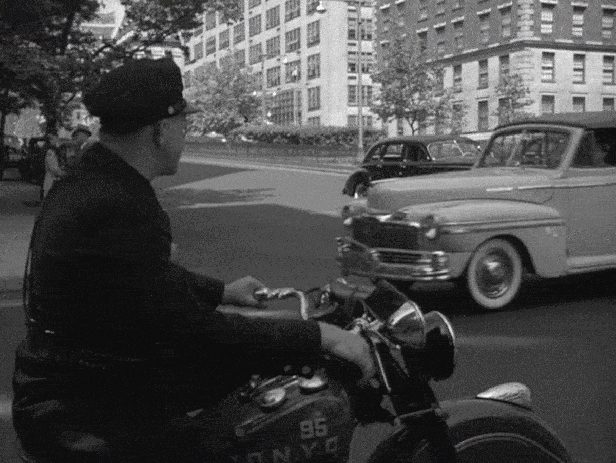
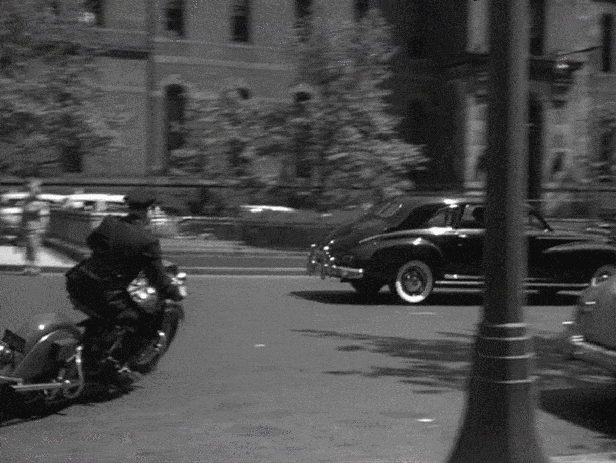
This image of a motorcycle cop chasing a speeder is the second shot in this movie’s varied opening montage (the first is of Broad and Wall Streets, which will show up again in the movie’s climax). Identifying the avenue wasn’t difficult since the voice-over stated they were on Park, although even without that, the presence of a median strip would’ve been an obvious giveaway.
Finding the cross street turned out to be pretty easy as well since the Park Avenue Armory is prominent in the background. I already knew the armory well after having recently identified it for a scene in Rosemary’s Baby, filmed just a few yards away from where the motorcycle cop was.
Introduction – Times Square
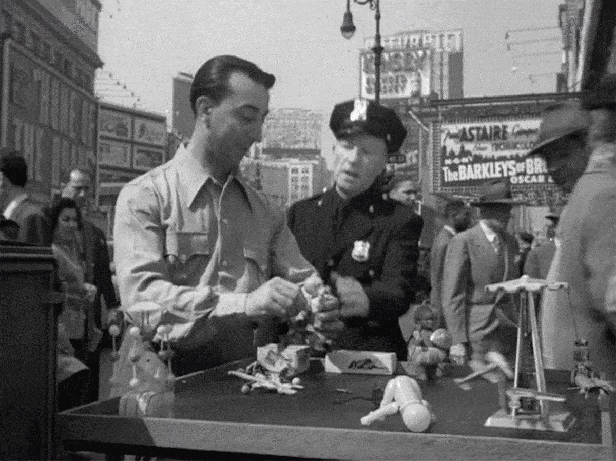
Whenever I track down old movie locations that took place in Times Square, the results are inevitably disappointing because things have changed so much there over the years. The majority of the old buildings have either been torn down or they’ve been altered so dramatically, they’re practically unrecognizable today. A perfect example is the Bond Clothing Store on the east side of Broadway between 44th and 45th Streets, whose building is still there, but looks nothing like it did fifty-sixty years ago when it was the centerpiece of the Square.
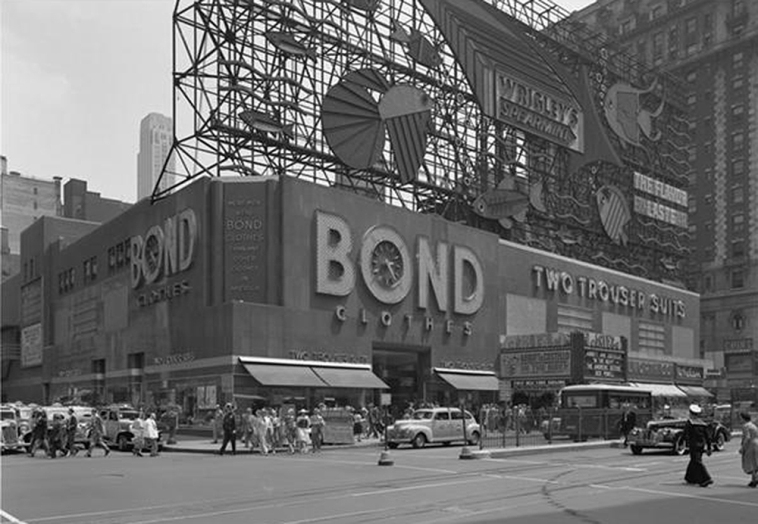
Coincidentally, this quick scene in Side Street took place on the corner of W 45th, which was at the north end of Bond Clothing. However, since you can’t see the clothing store in the shot, I actually figured out this filming location by identifying the Loews State Theatre at 1540 Broadway whose marquee appears in the background.
When Loews first opened its doors on August 9th 1921, it featured both movies and vaudeville shows, and continued to book vaudeville acts into the late 1940’s, long after its popularity had abated. Being located in the heart of Times Square, many world premieres were hosted at Loews over the years, including The Three Musketeers (1948), Some Like It Hot (1959), and the Godfather (1972).
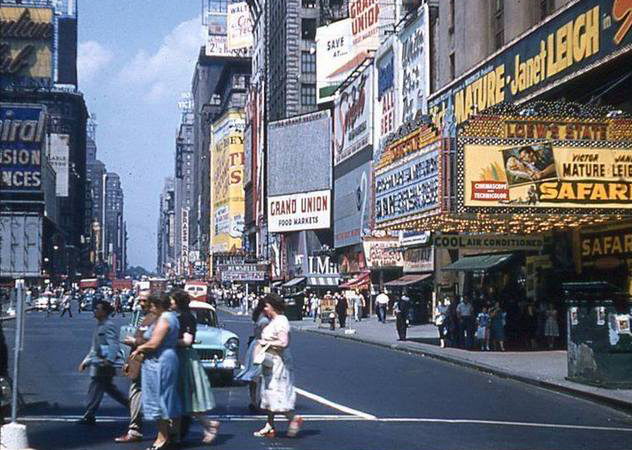
In early 1987, Loews State Theatre showed its last feature and the building was demolished shortly thereafter. By the 1990s, the address became home to a Virgin Megastore which had a short-lived four-screen multiplex, called the Loew’s State 4, in the basement.
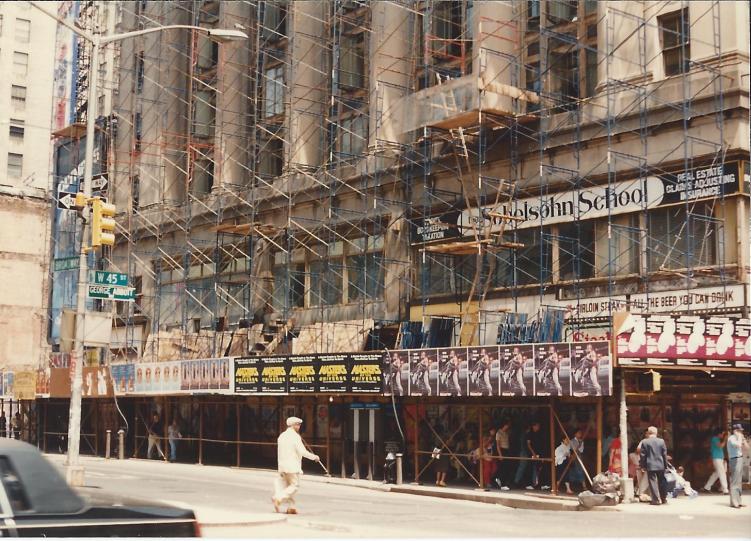
Even though the Times Square of today looks nothing like what it did when they filmed this scene in 1949, if you look closely at the “before/after” image above, you can see one extant building in the background that is remarkably unchanged. It’s the Brill Building (est. 1931), the striking Art Deco edifice located at 1619 Broadway, which appears in this scene in the far background, directly between the policeman and the street peddler. (The building was also prominently featured in the 1957 film, Sweet Smell of Success.)
Introduction – Fulton Market
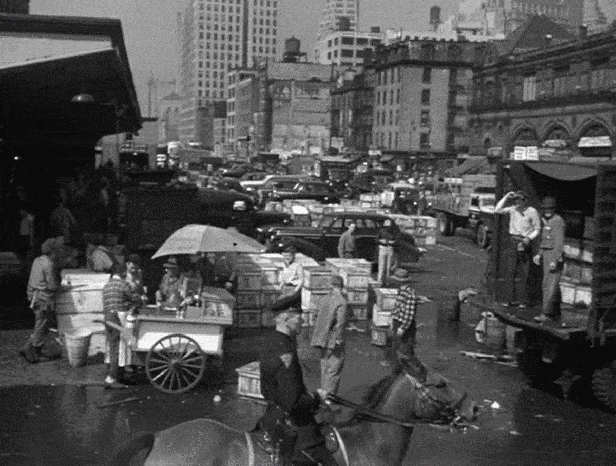
This location at “Fulton Market” was mentioned in the opening voice-over, so it wasn’t really a mystery where this scene was filmed. It just took me a minute to figure out the proper orientation of the shot.
What’s nice about this brief scene is that not only does it show the South Street Seaport in full-swing, but it also features the original Fulton Market Building at 11 Fulton Street before it was demolished. The block-wide market was eventually rebuilt in 1983, where the designers managed to retain the fish stalls from the original building. (Those stalls finally disappeared after the fish market officially moved to the Bronx in 2005.)
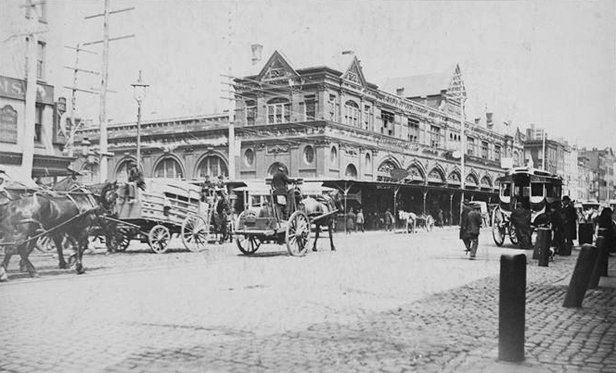
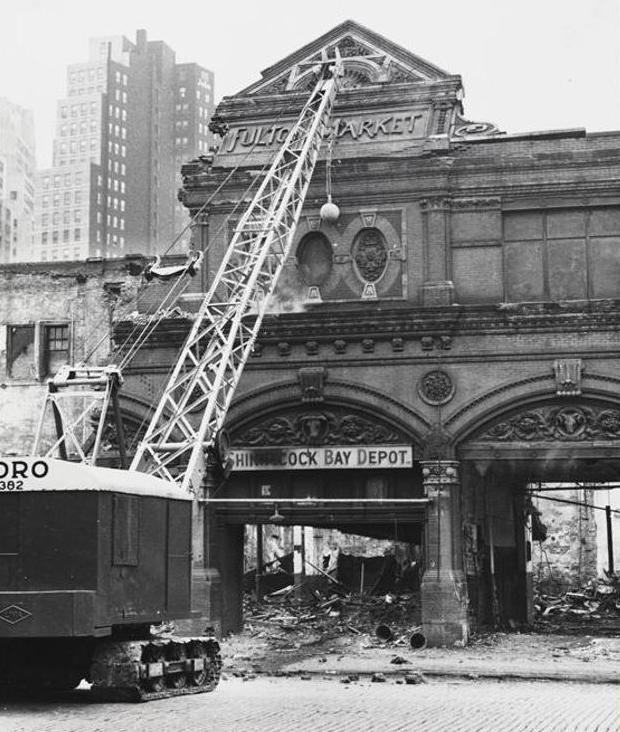
The interesting thing is, for a long time, I thought the three-story building at 11 Fulton was constructed long before 1983. With its metal canopies and high gabled roof, it looked like it was an early 20th-century industrial building that was just cleaned-up and slightly revamped over the years. (Although, turns out the building did actually have to be revamped after a blaze broke out in 1995, which then-mayor Rudy Giuliani claimed was the work of mobsters arsonists.)
With the fish market gone, the building at 11 Fulton is now home to a high-end multiplex movie theater and a variety of retail stores and eateries.
Introduction – Getting Married
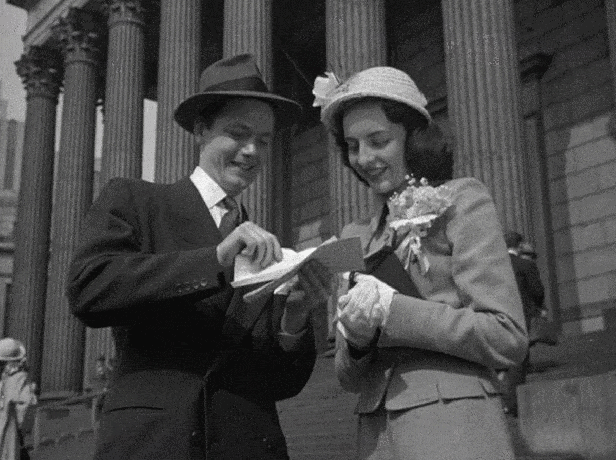
This scene was obviously filmed at a courthouse in downtown Manhattan, and I figured it was most likely the courthouse at 60 Centre — a building that had been used in several other films, including 12 Angry Men and Trading Places.
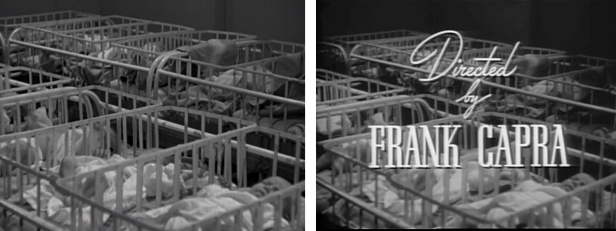
It should be noted that in the scene that immediately preceded this one, there was a shot of a maternity ward with rows of newborns in their cribs. I always assumed this was original footage for Side Street, but while watching Frank Capra’s 1941 film, Meet John Doe, I was surprised to see the exact same shot in the opening credits.
Since Capra’s film was made nearly a decade earlier, either the editors of Side Street borrowed that shot from John Doe, or both productions took it from a library of stock footage.
Introduction – Dead Person
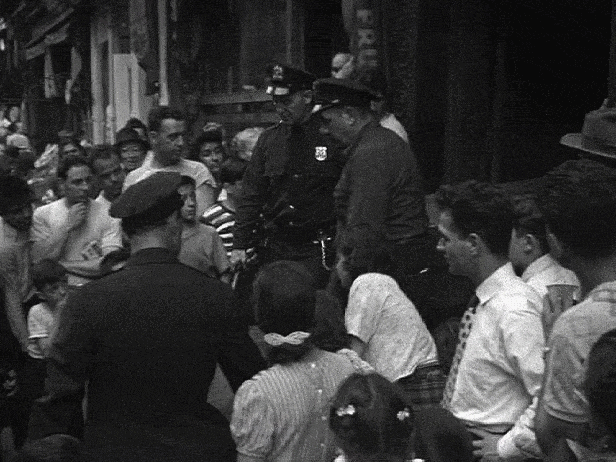
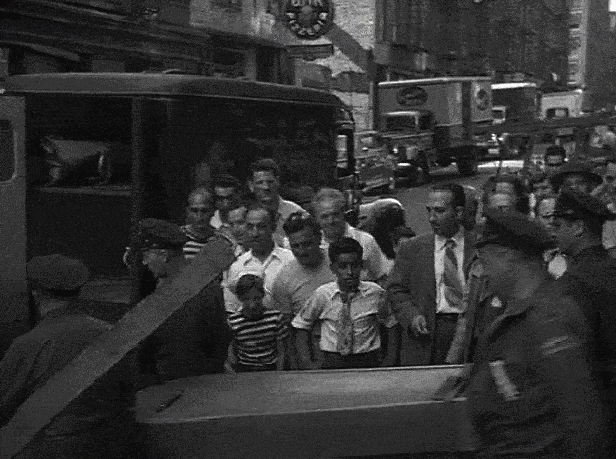
Since there weren’t any apparent landmarks in this quick scene, the biggest clue to go on was the pizzeria seen across the street, but I couldn’t make out its name.
Also working on this scene was my research partner, Blakeslee, who had recently discovered a complete 1946 Manhattan phonebook online with searchable text. So he searched for the word, “pizzeria,” but only got a few results and none of the addresses looked like what was in the scene.
Then a breakthrough came when he spotted what looked like a faint Empire State Building in the distance. From that, we were able to narrow down the possibilities, figuring the scene probably took place on a north/south street in Little Italy.
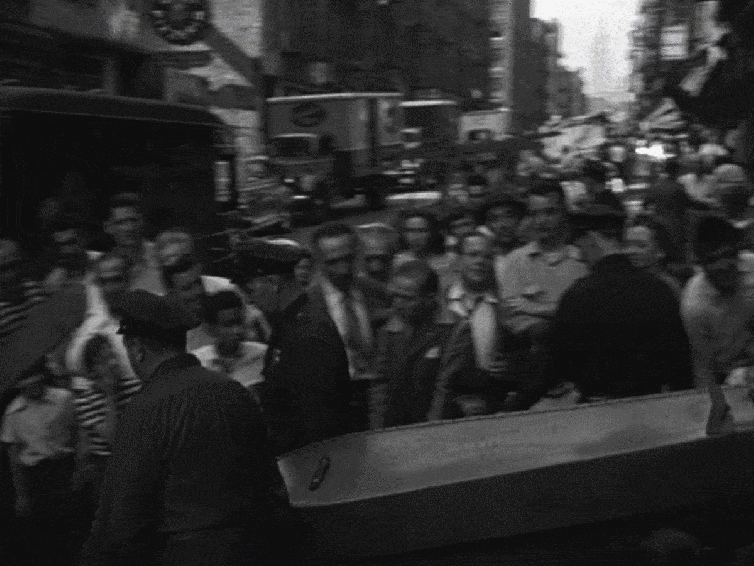
Next, Blakeslee then searched vintage maps for any streets in Little Italy with empty lots since we could see there was one next to the pizzeria, He finally ended up on Mott Street and concluded that the body was carted out of building number 150, confirmed by the etchings on the door frame which are still there today (albeit a little faded).
Once we certain of the location, we were then able to figure out the name of the pizza shop across the street, which was called Paul’s.
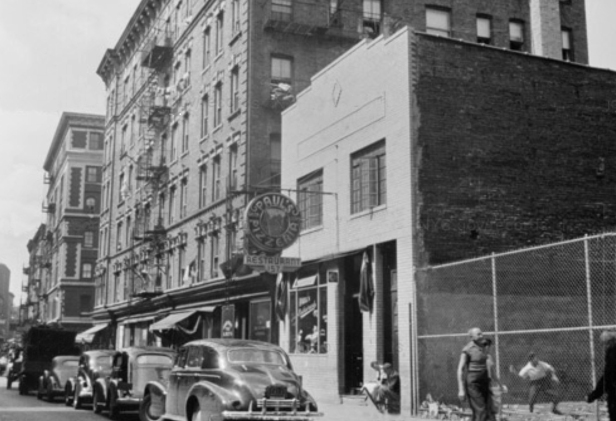
The empty lot next to Paul’s Pizzeria remained open for several decades until finally a 6-story building went up there in 1992. Surprisingly, aside from that, all the other buildings on that block are the same ones that appeared in this 1950 film.
Introduction – Fruit Stand
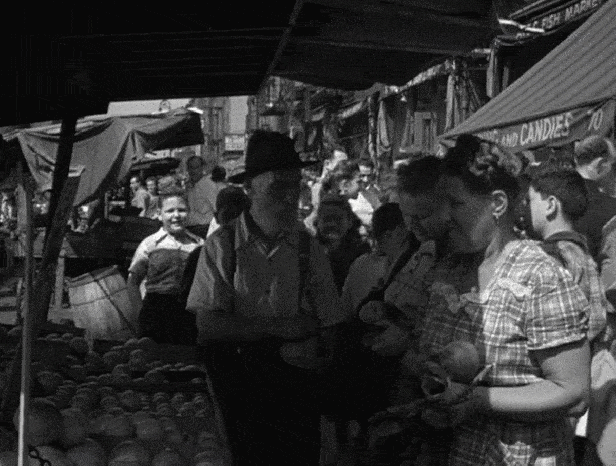
WIth all the street vendors, I thought this quick shot in the movie’s intro looked like it might’ve taken place on the Lower East Side.
After studying the scene, Blakeslee thought the awning at the top right corner of the frame said “AVE C FISH MARKET.” And since the awning below that had the number 70 on it, we deduced the scene took place at 70 Avenue C in the East Village (which was considered the “Lower East Side” in 1949 when this film was being made).
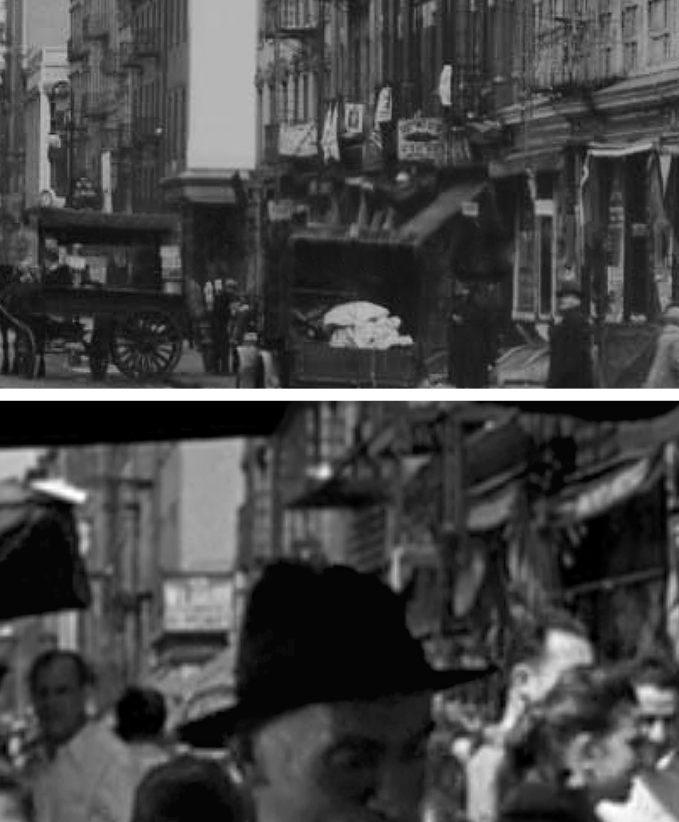
To help confirm this, I tracked down a 1926 photograph of Avenue C on the NYPL Digital Archives and found several details that seemed to match the film. The thing that stood out the most in that photograph was the corner building at 90 Avenue C with its noticeable lack of windows on the south-facing wall. making me fairly certain we found the correct spot.
Introduction – Hobos
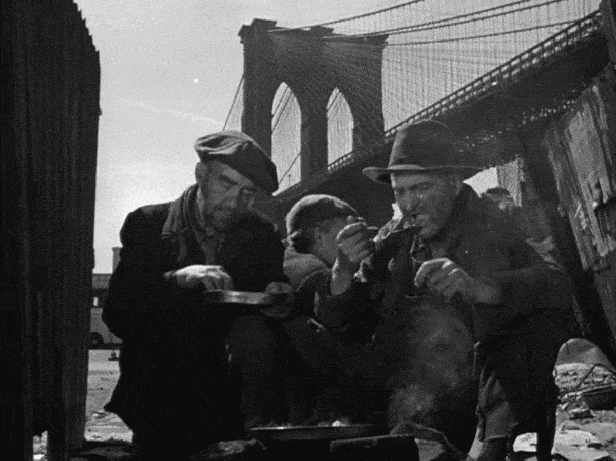
No explanation needed behind this location — it was clear that it was shot on the waterfront near the Brooklyn Bridge. At the time this scene was filmed, a lot of the waterfront area near the bridge was nothing but rubble, as several buildings were being demolished in preparation for a major construction of the Alfred E. Smith housing development. (See more about this area in the “On the Rooftop” scene below.)
This scene also took place shortly before the East River Drive (later renamed FDR Drive) was converted from a boulevard to an elevated parkway,
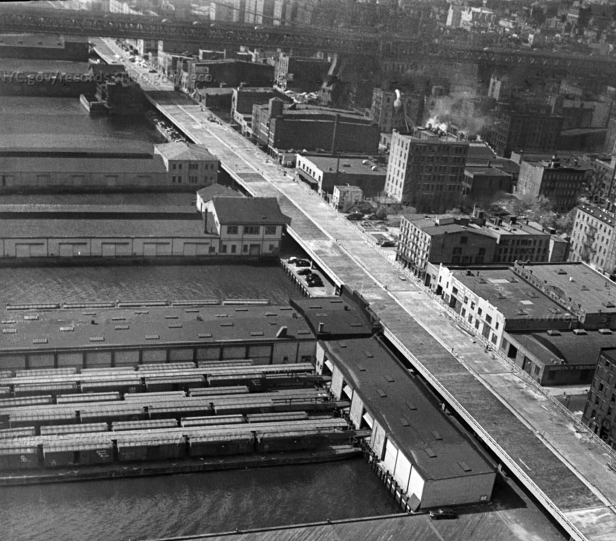
This section of the East River Drive was known as the South Street Viaduct and was completed in 1954. Less than 20 years later, it was proposed that the South Street Viaduct be turned into an underground tunnel, but this plan never came to fruition and the highway remains elevated.
Introduction – Religious Men
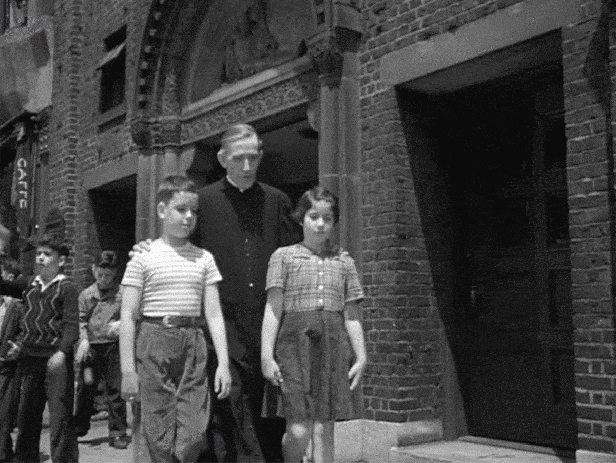
Blakeslee found this location on a hunch. He could see the collapsed awning on the left side of the frame had on it the word, “CAFFE” (Italian for coffee), leading him to believe that this scene took place somewhere in Little Italy. So he did some poking around the neighborhood until he found a match with the Chapel of San Lorenzo Ruiz on Broome Street (formerly the Church of the Most Holy Crucifix).
When he shared his findings, I was pleasantly surprised to see that the building was still there and practically unaltered. But unfortunately, that all changed a couple years later when the Archdiocese of New York declared that the chapel was no longer sacred. The property was promptly sold for a little over $7 million to a real estate developer with plans to demolish the site.
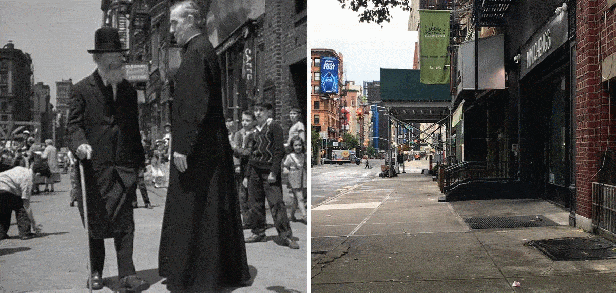
As disappointing as this news was, the one saving grace is that almost all of the other buildings that appear in this scene (when the camera pans to the left) are still standing today. And I’m thankful I was able to get to the location in 2018 and see that tiny Roman Catholic chapel in person before the wrecking ball turned it into nothing but a faint memory.
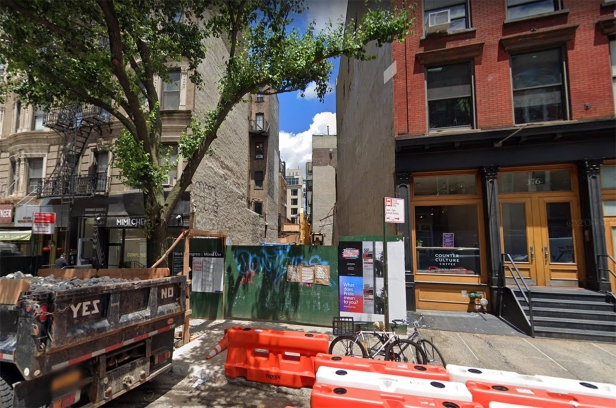
2022 UPDATE:, In 2019, the chapel was completely demolished and by late 2021, construction of a new building began. It’s still a work-in-progress, but renderings give us an idea of what it will look like when completed — sleek, modern and undoubtedly super expensive to rent.
Introduction – Superstitious Ladies
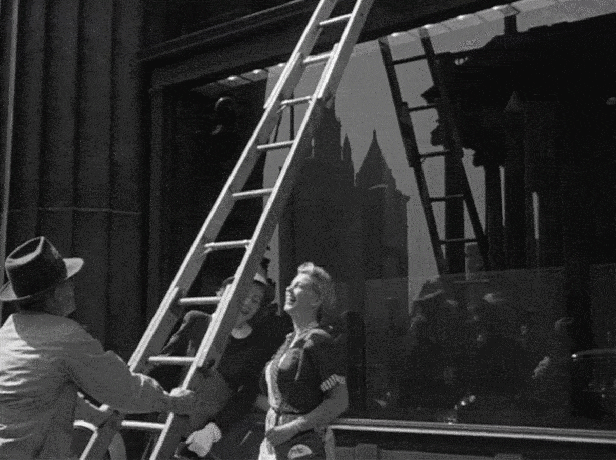
This location was identified from the reflection in the window showing the tower of the large Dinkins Manhattan Municipal Building in Downtown Manhattan. Then, after looking around that area a bit, I figured out that the building with the ladder propped up against it was on the corner of Broadway and Fulton, across from St. Paul’s Chapel (which also appears in the reflection).
Introduction – Ferry Terminal
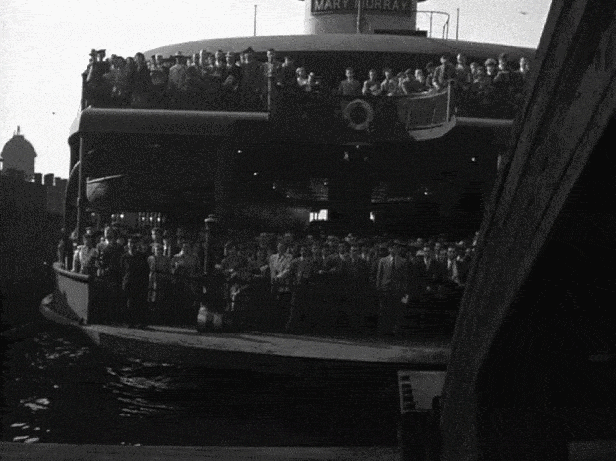
Figuring out this location wasn’t a major issue, as I assumed that this quick shot was of a Staten Island Ferry coming into the Whitehall Terminal in Manhattan. But just to be sure it wasn’t a shot of another commuter ferry line, I researched the name “Mary Murray,” which was painted on the bow of the boat, and found out it was, indeed, the name of a Staten Island ferry.
Turns out Mary Murray was a Quaker woman who, according to legend, delayed a British General during the American Revolutionary War to help allow George Washington’s troops to escape New York. As the story goes, after a defeat in the Battle of Brooklyn, General Israel Putnam and around 5000 of Washington’s soldiers were retreating north on Manhattan Island, when British military forces prepared to trap them up near Kips Bay. However, Mrs. Murray convinced British General William Howe and his staff to repair to her nearby mansion (located at what is today Park Avenue and 36th Street) for cake and wine, keeping them distracted as the patriots were able to slip away.
As to the Staten Island ferry, the 252-foot-long Mary Murray was first launched in 1937, and operated in the New York Harbor until 1974 when it was permanently docked. Two years later, the steamboat was sold at an auction for $25,000, with the new owner intending to turn the vessel into a museum or restaurant. Unfortunately, those plans fell through and the Mary Murray just sat rusting on the Raritan River until it was finally dismantled, beginning in 2008.
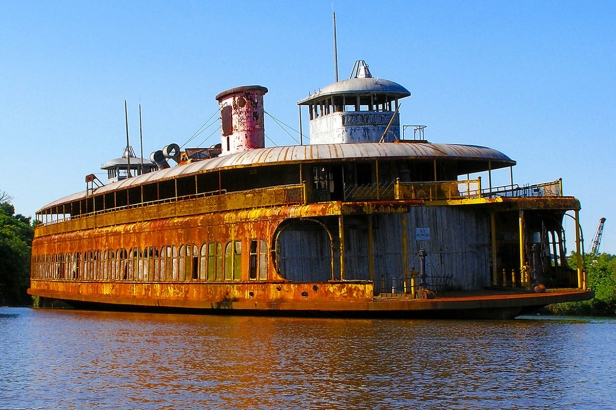
After I confirmed the Mary Murray was a ferry for Staten Island, I was confident this brief shot in Side Street took place at the original Whitehall Ferry Terminal in Manhattan. This was just a few years before the terminal was remodeled in 1953, and before it was completely rebuilt in the early 2000’s.
Introduction – Central Park
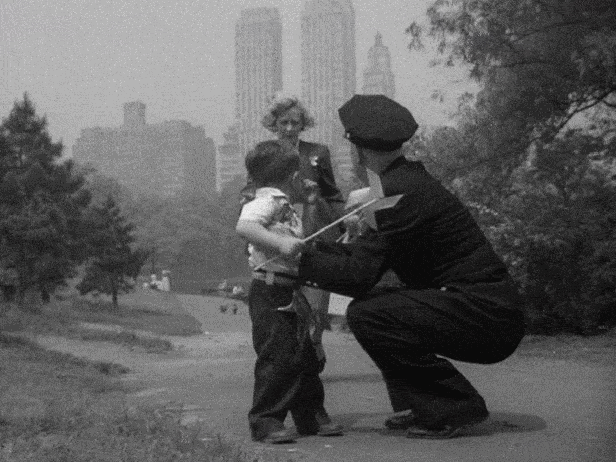
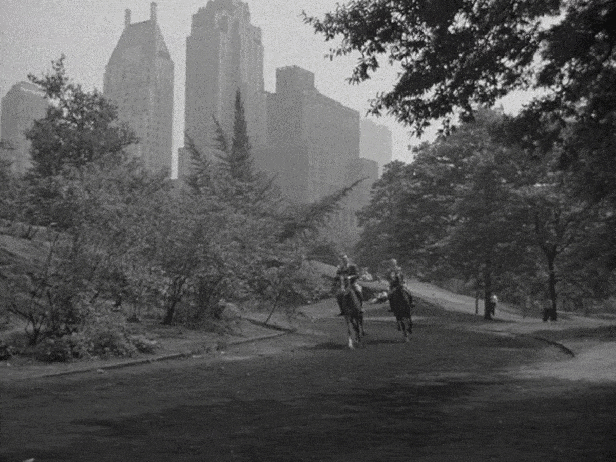
Both these quick shots in the opening montage obviously took place in Central Park.
The two clues to help me figure out the location of the first shot were the small body of water on the right side of the frame and the twin towers of the Majestic at 115 Central Park West in the background. From that, I was able to determine the scene took place on the pedestrian path just southwest of where Bow Bridge crosses the Lake.
The location of the second shot with the people on horseback was also solved by using the skyscrapers on the horizon as a guide, in particular the Hampshire House at 150 Central Park South, with its distinctive steep copper roof and twin chimneys.
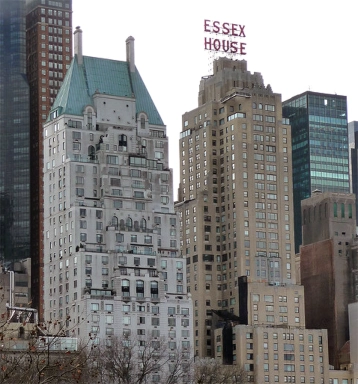
Figuring out both the angle of the roof and its relation to the neighboring Essex House got me to the general vicinity of the scene, but I had to go to Central Park in person to find the the exact spot. And since I could see they filmed on the bridle path, it helped narrow down the number of places it could’ve been in the park (assuming the path hadn’t been dramatically rerouted since 1949).
Once I arrived at the park, I just followed the path south from around 65th Street until the landscape started to match up — right around Pine Bank Arch. Not only did those skyscrapers on Central Park South line up perfectly with the bridle path, I noticed the rock outcroppings and several trees have survived since 1949.
.
Looking in a Store Window
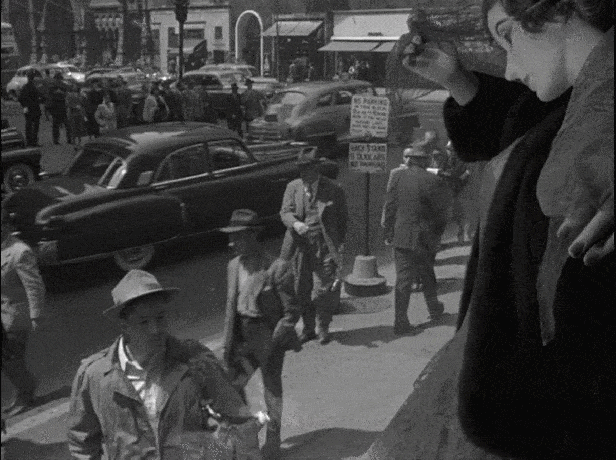
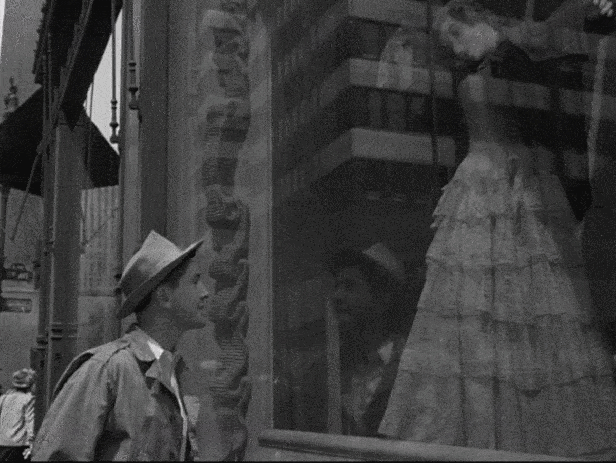
Finding this scene’s location took a little investigating, but I was able to do it within a couple hours.
The first thing I noticed in the scene was a street sign that appeared in the background as Joe walked away. It was a little blurry, but it looked like it said 5th Ave, which made sense since 5th has many stores like the one in the film.
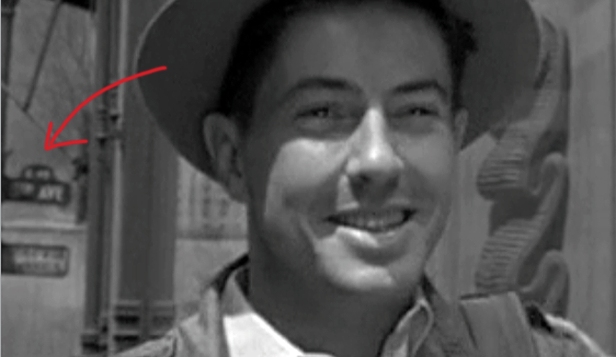
I also noticed that in the wide shot looking across the street, there appeared to be a medium-sized church on the far corner. Assuming we were on Fifth, I searched for any corner churches that were on the avenue between 14th and 59th Street.
Modern street views on Google didn’t show any corner churches that matched the one in the film, so I checked the 1930 land book to see if there were any corner churches on Fifth Avenue that have since been removed. After looking through several pages, I came across “Collegiate Church of St. Nicholas” on Fifth and 48th. As promising as that looked, the one thing that temporarily puzzled me was the fact that the church was on a block that is currently occupied by Rockefeller Center, and I was pretty sure Rockefeller Center was already built by 1949.
This discrepancy aside, I thought the block was definitely worth a look. After studying the area, I eventually zeroed in on the entrance to 608 Fifth Avenue which matched an entrance with a curved top from the film. (The curved section has since been filled-in so it’s a little harder to see.)
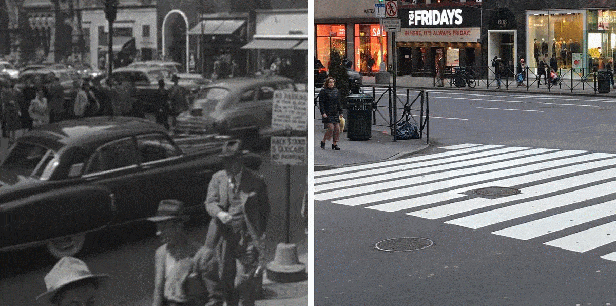
After matching up the curved-top entrance, I was able to determine that Farley Granger’s character was standing in front of Saks Fifth Avenue. As further evidence that I got the right place, I spotted several buildings reflected in the store window in the film that are still there today.
Once I confirmed this location, I did a little research on the history of Rockefeller Plaza, and it helped clear up the thing that originally puzzled me about the church’s location. It’s true that most of the Rockefeller complex had been completed a good while prior to the filming of this scene, but with one exception — the corner lot at 600 Fifth Avenue where Collegiate Church of St. Nicholas used to stand.
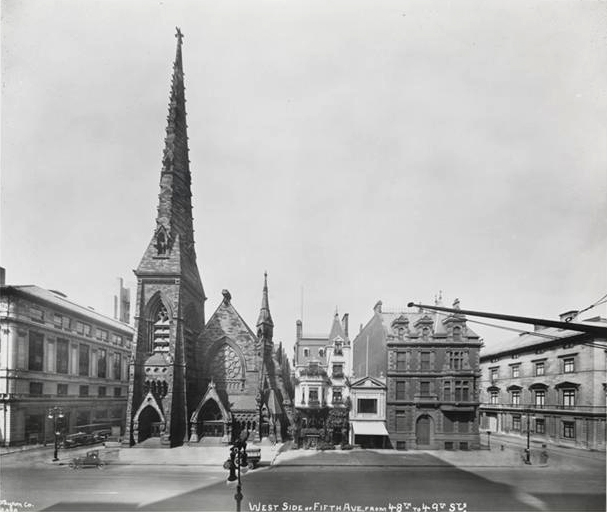
Since the current building at no. 600 contains architecture similar to the original Rockefeller complex, I just assumed it was constructed at the same time as the rest of the buildings, but it was actually built by a private developer in the 1950s and was only acquired by the center in 1963. And with that, I was done with this quick introduction to the film’s main character, Joe Norson.
Chatting with a Cop
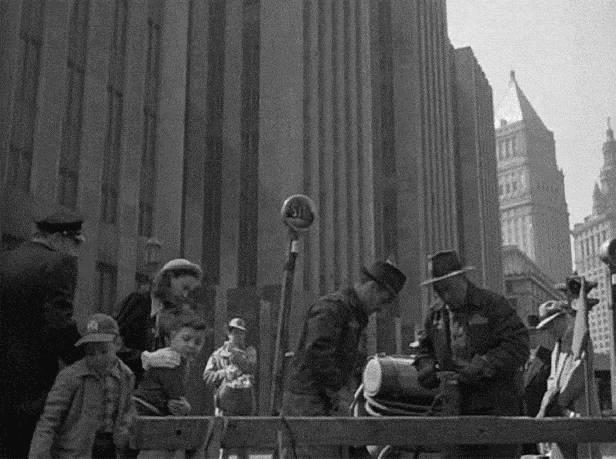
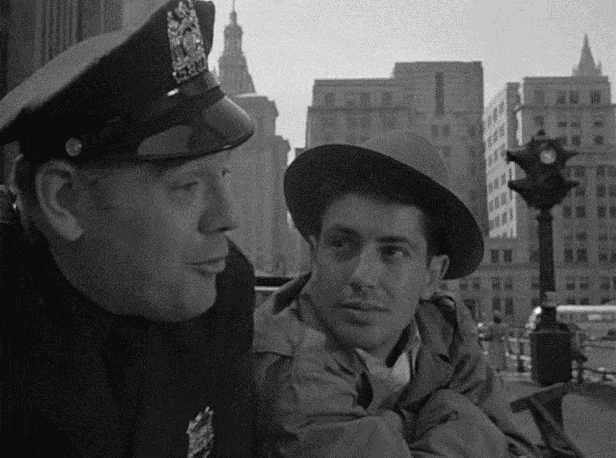
For some reason, this location fascinated me. The vertical art-deco-looking buildings in the background in an otherwise open space seemed unusual and not like anything I could picture in New York. The buildings looked more like a lost set from Fritz Lang’s Metropolis.
I ended up figuring out this location by first finding the location of the following scene at the lawyer’s nearby office building. Once I located that spot, I began searching the general area to see if I could find the buildings from this scene and eventually landed on the New York Criminal Court, which perfectly fit the bill.
Stealing the Money
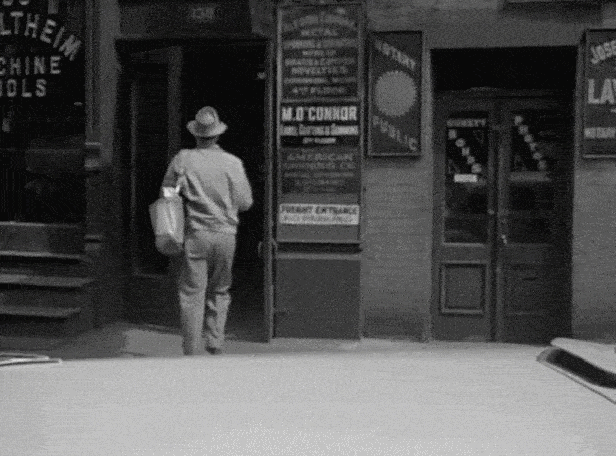
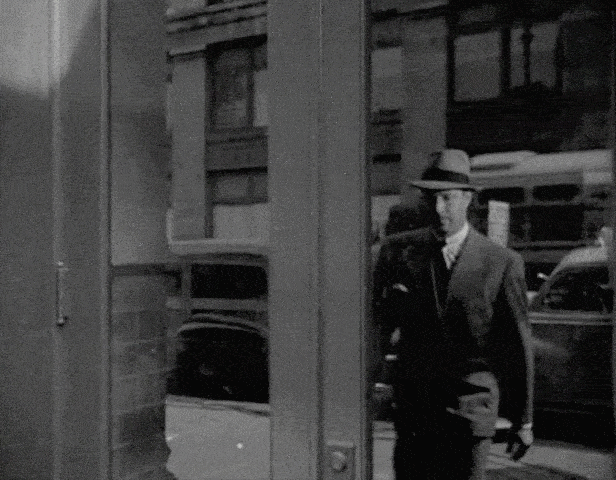
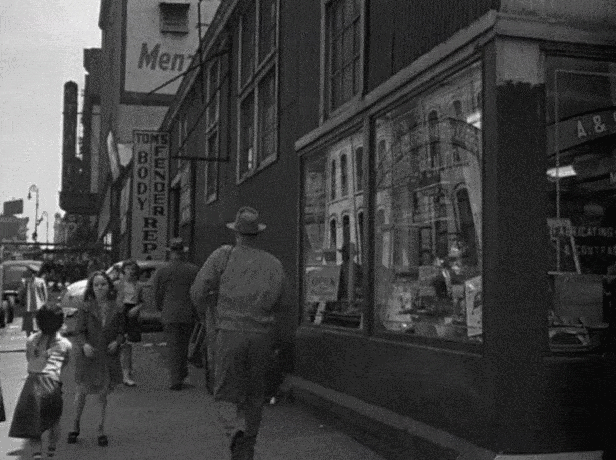
Of all the locations in this film, I thought the lawyer’s office building had the most charming archaic quality to it, and I was eager to find it. There weren’t any obvious landmarks in this scene and only clues I had to go on were the signage near the entrance and an address of “136” on the neighboring building.
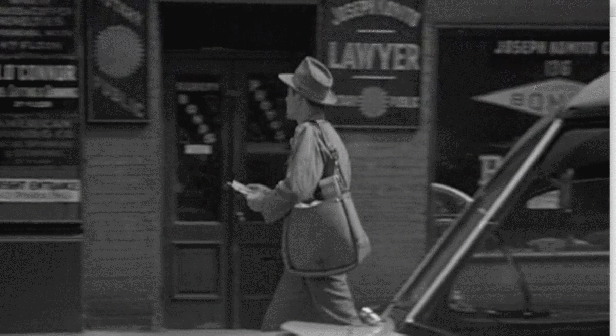
At first, I thought the signs by the entrance might’ve been fake, placed there by the film’s art department. However, after focusing on the sign for “Joseph Komito – Lawyer & Notary Public,” I found several references online to a New York attorney and notary by that name, suggesting that those signs were real.
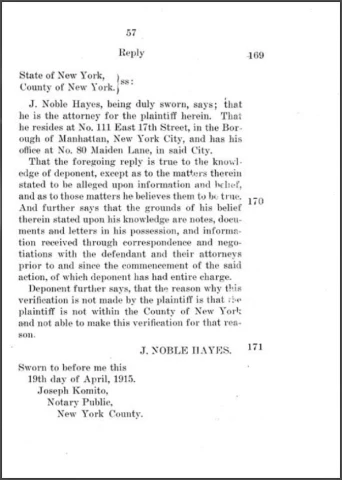
Unfortunately, I couldn’t find an address to his office, nor could I find an address to any of the other businesses on those posted signs, so I went to the 42nd Street Public Library to look up the lawyer’s name in a 1950 phone book. (This was actually the first time I used the library’s collection of phone directories to help me find a location, and it take me long to recognized the real value of this handy resource — one that I would utilize many times in the future.)
After searching the phone book, I found a “Joseph Komito” at 138 Centre Street, which sounded promising since the neighboring building had the number 136 on it. (Again, since this was the first time I used the library’s collection of phone directories, I got a real charge when found my first match.)
Sadly, the lawyer’s building is no longer there (having been torn down in the early 80s), but the building across the street at 133 Centre is still around. (You can see it reflected in the door window in the 2nd “before/after” image above.)
Months later, after watching the trailer for Side Street, I noticed that they included an alternate shot from this scene that showed more of Centre Street, and more extant buildings, further confirming this location.
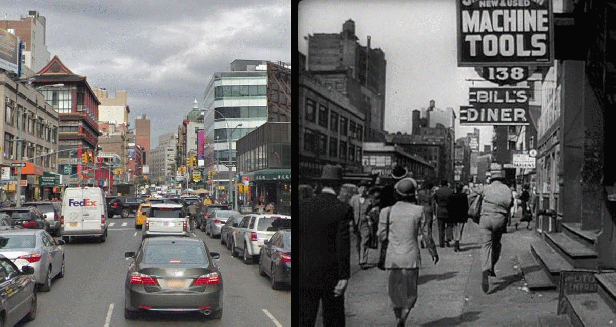
As to the scene of Joe walking back to his neighborhood with the stolen loot, I figured out the location by looking up “Tom’s Body Fender Repair,” whose sign is prominently featured in the shot, in the 1950 phone directory.
I found out that the repair shop’s address was 115 Walker Street, but I also found out this building’s fate was the same as the lawyer’s office — it, along with the entire block, got razed in 1991. However, after scanning the background, I noticed that the distant building at 125 Canal Street was still around today.
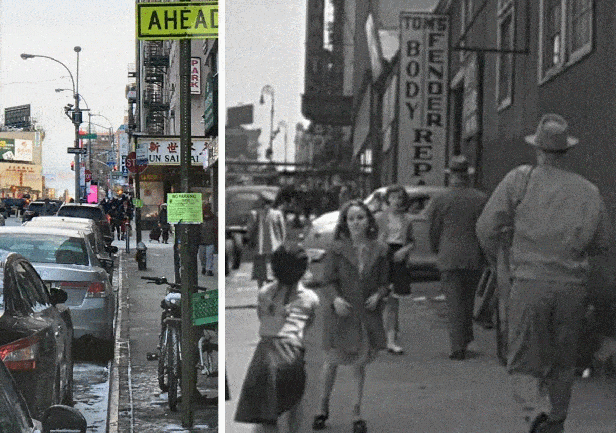
What made the discovery of this extant building more exciting was the fact that the billboard on its roof is still in place today. The only change that has taken place over the years is that instead of advertising cigarettes, the billboard now probably advertises some new CGI-saturated superhero movie.
On the Rooftop
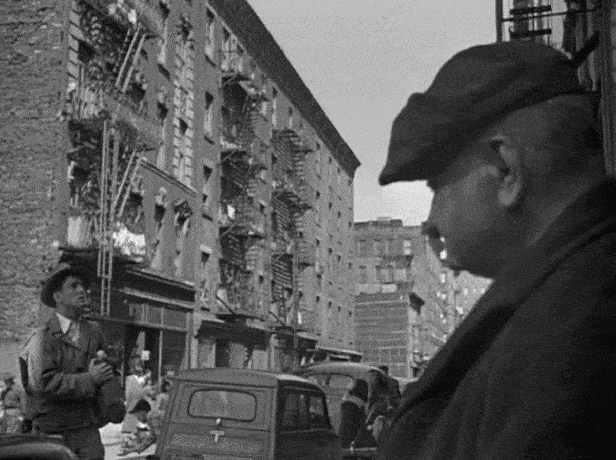
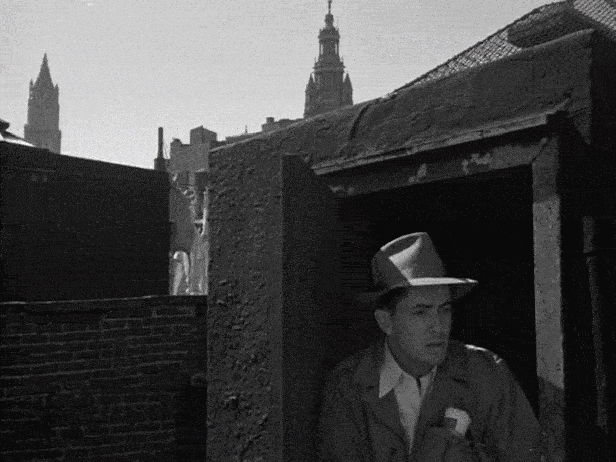
Rooftop scenes are usually the most difficult to find an exact address for since all you normally can see are nondescript tops of neighboring buildings. However, finding the general location of a rooftop scene is usually doable because the shots will often show unobscured views of the outlying skyline, which undoubtedly will include one or two landmark buildings. And one nice thing about this rooftop scene is that here’s also a quick shot of Joe entering the building from the street, offering an alternate perspective of the location (assuming everything was filmed at the same place).
This was a scene I revisited several times, and each time I did, I’d get closer and closer to pinpointing the exact site.
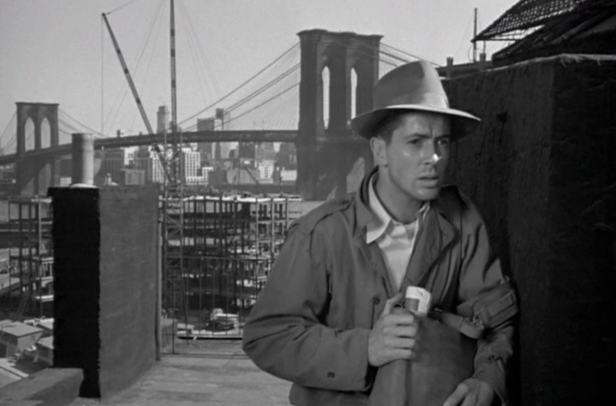
When I first began my hunt, I could tell this scene took place somewhere in lower Manhattan since you can see the Woolworth and David Dinkins Municipal Buildings from the roof, as well as the Brooklyn Bridge. Based on those landmarks, I approximated that they were somewhere between the Brooklyn and Manhattan Bridges on the Lower East Side
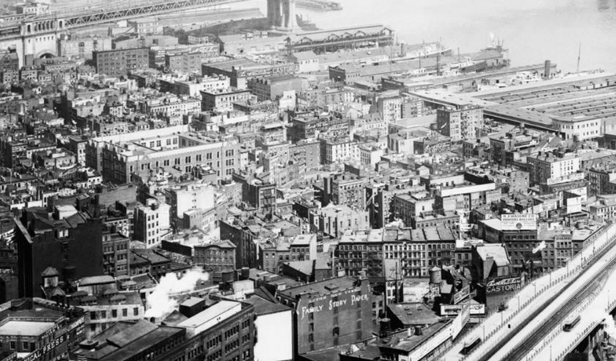
A few months later, I revisited this scene and tried to get a better fix on its location. Looking at how the rooftop was in relation to the Brooklyn Bridge, I estimated that they were about four or five blocks north of where the bridge met the river. That would put the building close to where the Alfred E. Smith Houses now sit — a public housing development that was built between 1951-1953. When the city constructed these housing units, the area had to get completely razed, so I knew figuring out the exact address of the rooftop would be all the more difficult.
But still determined to solve this mystery, I surveyed a 1930 map of the neighborhood and eventually estimated that the building Joe entered was likely on James Street just south of Madison.,

Turns out my estimate was close, but not exactly right. I learned this a few months later as I was planning a trip to the Lower East Side to take modern photos of the area. Before traveling there, I asked Blakeslee if he’d like to take a crack at this scene. As he did that, I decided to check out the NYPL Digital Archives to see if I could find any Manhattan photos labeled, “James Street,” and found one from 1927 that turned out to be very promising.
Comparing the 1927 photograph (top) to a still from the film (bottom) was a little tricky because they were taken from reverse angles, but the corner building (indicated with arrow) and the adjacent fire escapes (circled) seemed to be a match. Pretty confident I was closing in on solving this mystery, there was still one problem — the 1927 photo from the NYPL archives was simply labeled “James St. + Oak St.” but didn’t indicate which street was which, or what direction we were facing.
Right around this time, Blakeslee was looking through the NYC Municipal Archives and stumbled upon a wonderful high-resolution photo from 1902 of a public school building. Luckily, the photo featured a clearly-marked street sign (whose marvelous design was something I had never seen before), indicating we were on Oak Street looking towards James.
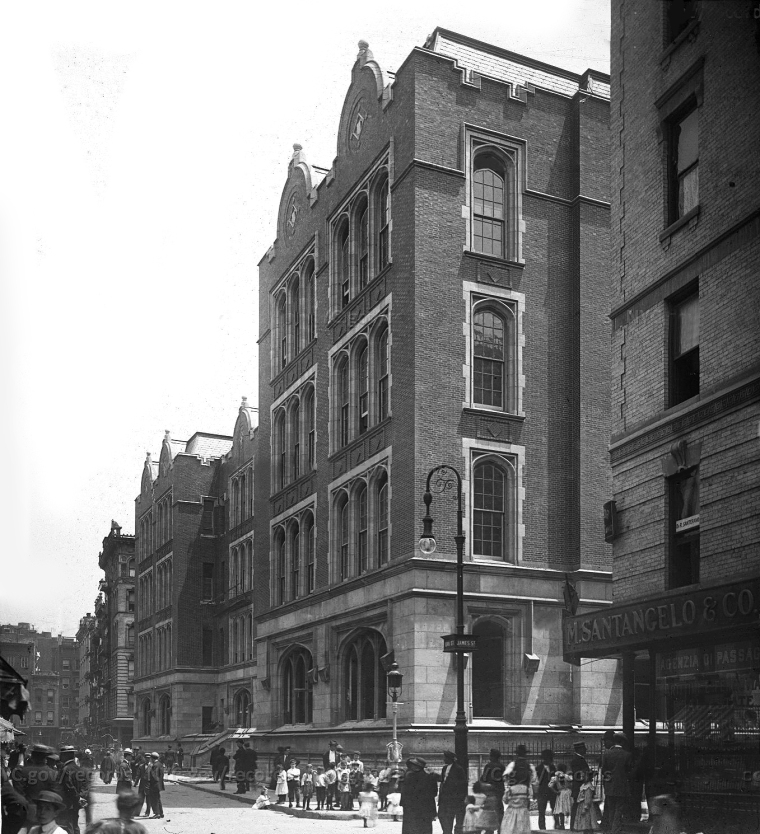
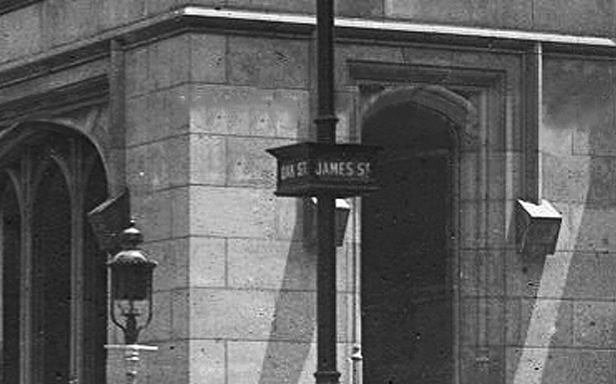
When I compared this 1902 photo with the 1927 photo I had previously found, I was able to single out several matching elements and concluded they were at the same intersection, but taken from reverse angles.
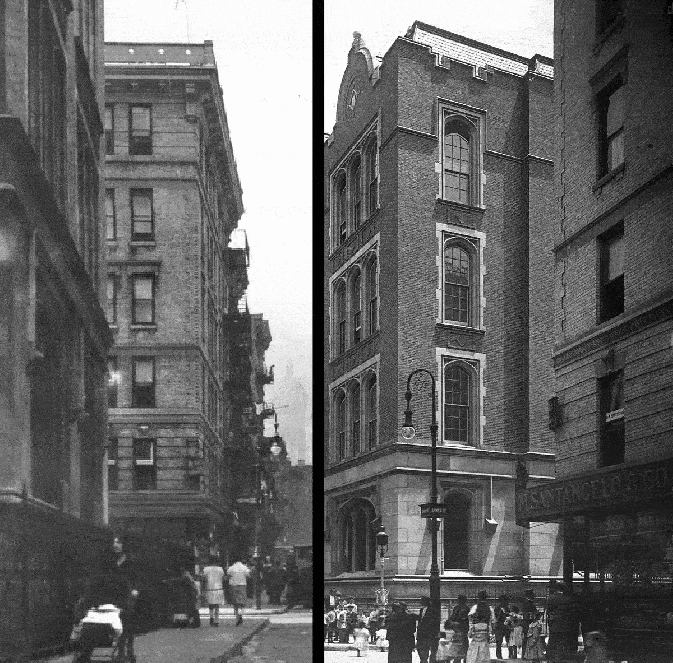
After I was able to decisively link the 1902 photo to the 1927 photo, I could then link the 1927 photo to the 1950 film, concluding they shot the scene on Oak Street just west of james. Then Blakeslee went to the vintage land book and used the building heights marked on the map (measured in floors) to pinpoint the exact address — 27 Oak Street.
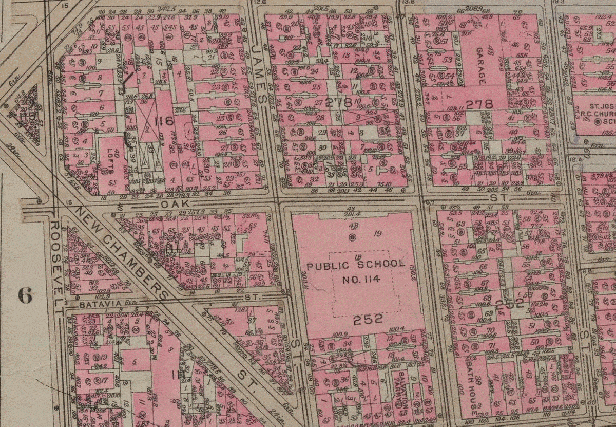
Once I knew the location was 27 Oak Street, I did a more narrow search on NYPL’s digital archives, and found a photograph taken from New Chambers Street (circa 1919) looking down Oak Street towards James. The image was a bit damaged, but it gave me a perspective closer to that of the film.
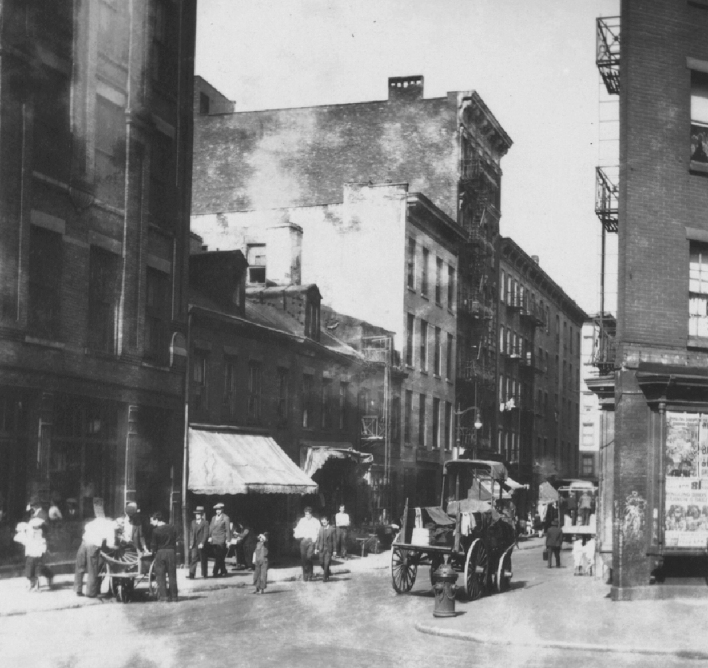
But the real icing on the cake was a photograph I found from around 1940 which was taken from 29 Oak Street (almost the exact same spot used in the film), further confirming our findings.
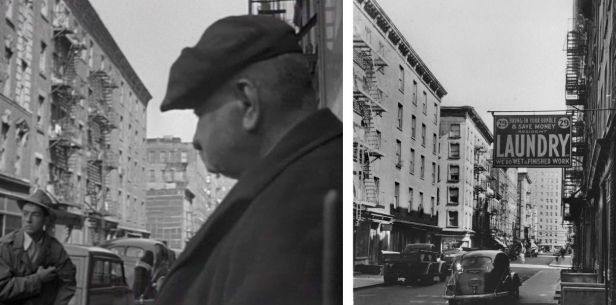
Actually the real icing on the cake came a few weeks later when I went down to the Lower East Side to take some photos.
Standing in the middle of the Alfred Smith housing complex, I was trying to get my bearings so I could take a picture that was as close to the actual filming site as possible, but I quickly got lost in a jumble of identical giant residential buildings. As I tried to figure out which way to point my camera, I suddenly came upon a landmark I hadn’t expected to see — the public school building from that 1902 photo!
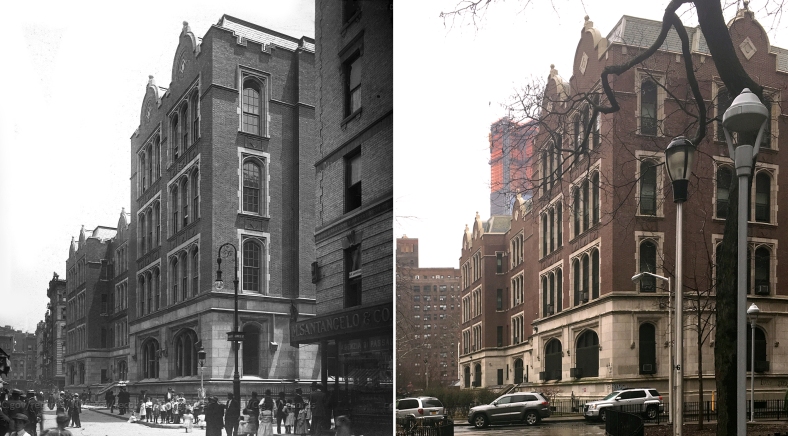
I immediately texted Blakeslee a pic of the school and he was equally flabbergasted. Somehow, neither one of us realized the building had survived the massive redevelopment that took place in the 1950’s. Goes to show that sometimes it helps to get out from behind a computer and go exploring in the real world.
East River
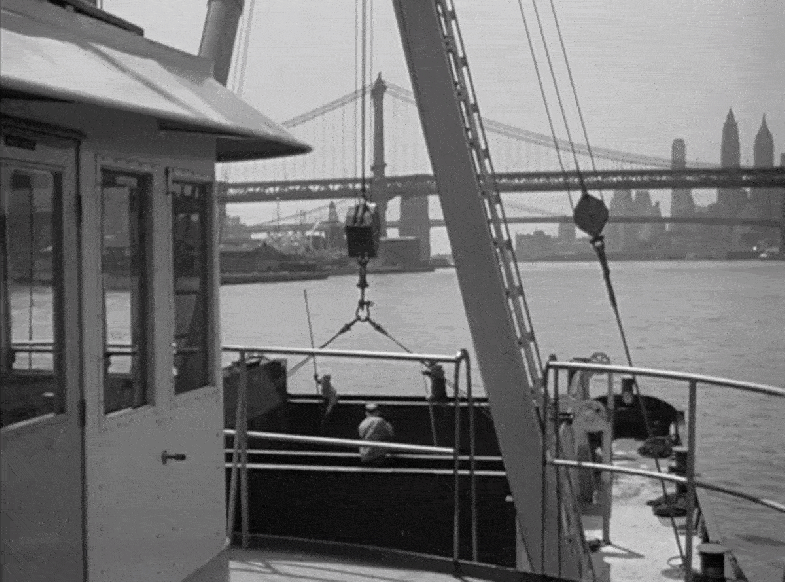
Most New York river scenes take place in the East River, mainly because it offers picturesque views of the three local bridges connecting Manhattan to Brooklyn. And it’s these bridges that often aid in figuring out the general location of these scenes.
While most of this river stuff was shot on location, I can only assume the close-up of the body floating in the water was done in a tank back in hollywood.
A Waterfront Hotel
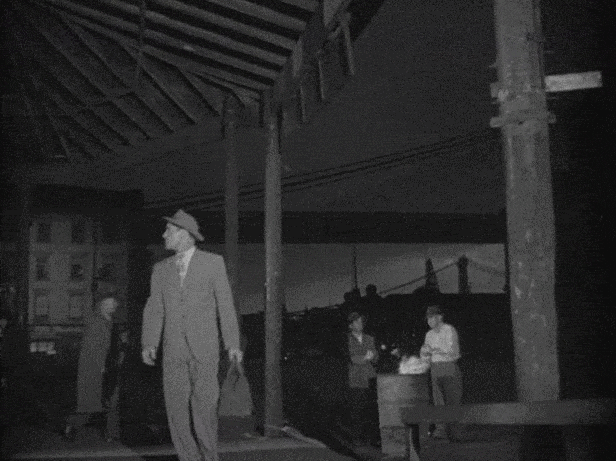
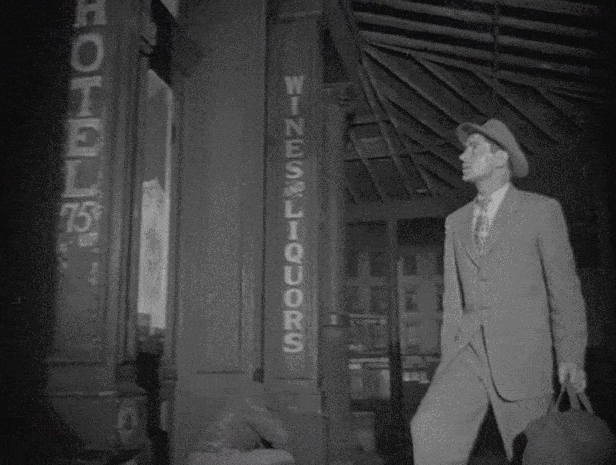
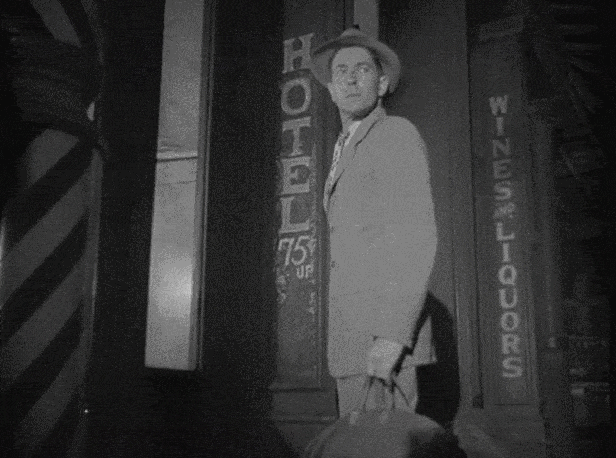
This was a location I waited a long time before pursuing, mostly because I figured the waterfront hotel used in this scene was long-gone. But with the prodigious Brooklyn and Manhattan Bridges in the background, I knew I could at least find the general location.
Figuring the hotel was a few blocks southwest of Brooklyn Bridge, I started looking for any extra-wide cross streets since the one in the scene looked quite expansive, and eventually landed on Peck Slip. A quick trip to Google Street View and I noticed that the building on the southern corner of Peck and South Street resembled the hotel from the film, with a similar-looking awning and wooden poles.
Turns out the building (est. 1873) used to be home to the Meyer’s Hotel, which seemed to give credence to it being the film location.

Luckily, I was able to find several vintage photos of the nearly 150-year old building online, but it was a 1981 photo of the entrance to the adjacent bar that helped convince me I found the correct filming location. In the photo, you can see a very distinct-looking address plaque by the door which seemed to match the one seen outside the hotel entrance in the film.
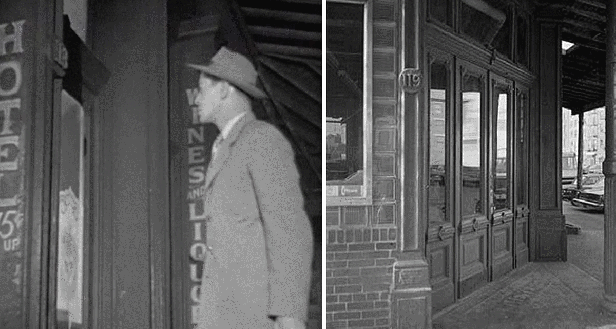
Once I went to the building in person, I found another plaque where the Meyer’s Hotel entrance used to be, and it had the number 118 —the same number in the film— making me confident that that is where they shot this scene.
Even though the hotel has since been converted into private condos, the attached tavern at 119 South Street, now called Paris Cafe, is still open for business and well-worth visiting if you find yourself in Downtown Manhattan. Inside, you’ll discover many original fixtures still in place, including the spectacular polished wood bar where such luminaries as Teddy Roosevelt, Thomas Edison, and outlaws Butch Cassidy and the Sundance Kid purportedly once drank.
Reading the Newspaper
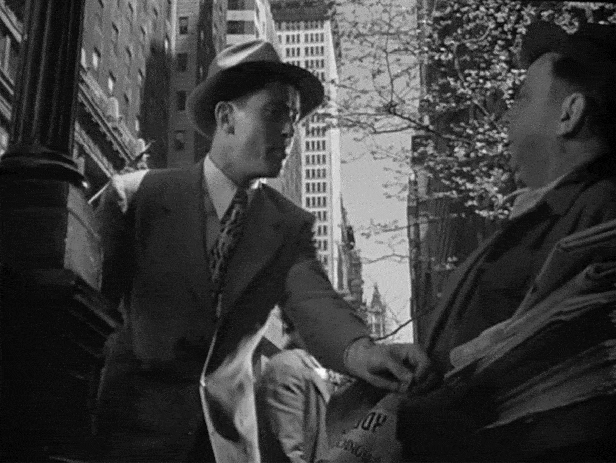
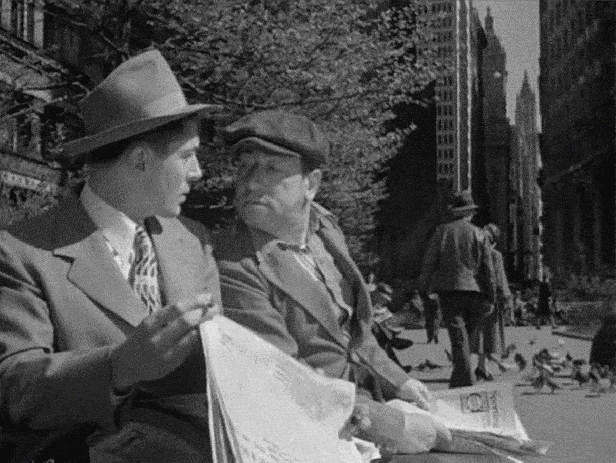
This was not a terribly challenging location to find since Bowling Green is a distinct little park with the fairly recognizable Standard Oil Building just behind it.
Once I was certain where this scene was filmed, I realized that the tower that appeared in the far distance was the Woolworth Building at 233 Broadway. Interestingly, the Woolworth building, which is over a half mile away from Bowling Green park, looks like it’s only a block or two away in the scene — all thanks to the magic of the movie camera lenses.
Joe’s Apartment
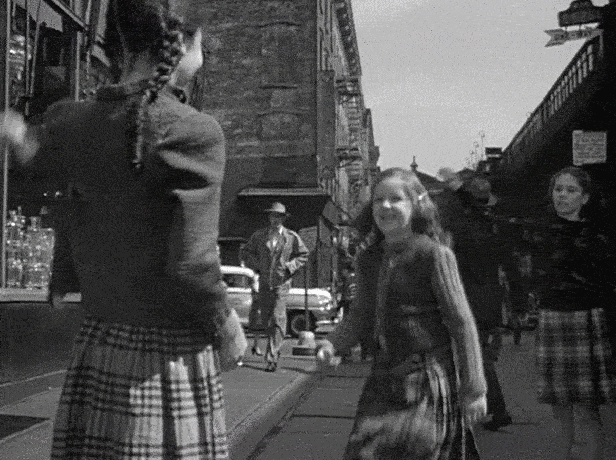
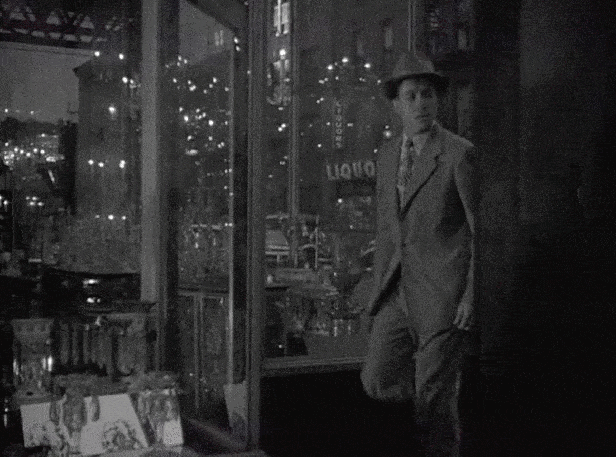
This is one of two locations where its address is explicitly disclosed in the course of the film (see “Beauty Shop” below for the other). In this case, it happens when Joe tries to return the stolen money, and he tells the lawyer that he lives at 850 Third Avenue.
Since the first scene of him returning to his home featured an elevated train, I was pretty sure it was, in fact, filmed on Third Avenue. However, since most of the area near no. 850 has been replaced with modern skyscrapers, I needed to search through some vintage photos to see if I could confirm the address he gave was correct. If they really did film the scene at 850 Third, that would take us to the west side of the avenue between E 51st and E 52nd Streets.
After looking through the NYPL Digital Archives, I was able to find a 1936 photograph of Third Avenue. Looking north from 51st, the photo featured a delicatessen and a barber shop — both of which can also be seen in the film when Joe enters the apartment at night.
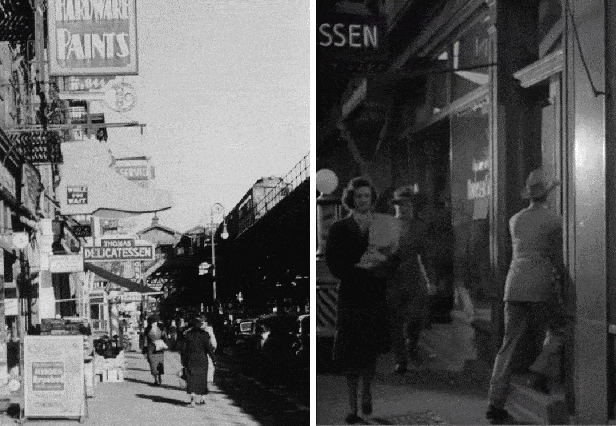
About a year later, when the 1940s tax photos were released, I found another image of the old apartment building at number 850.,
Playground
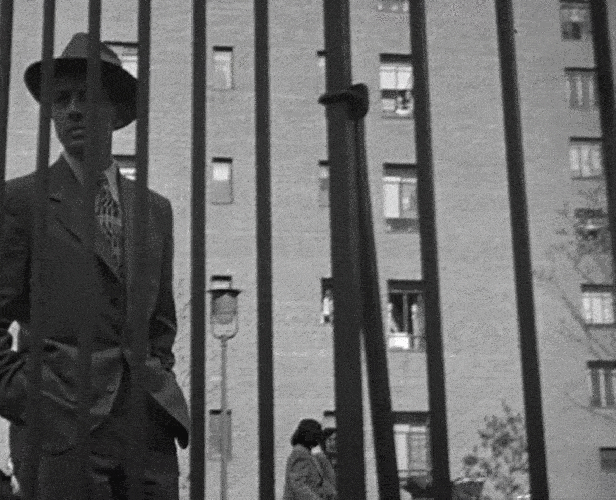
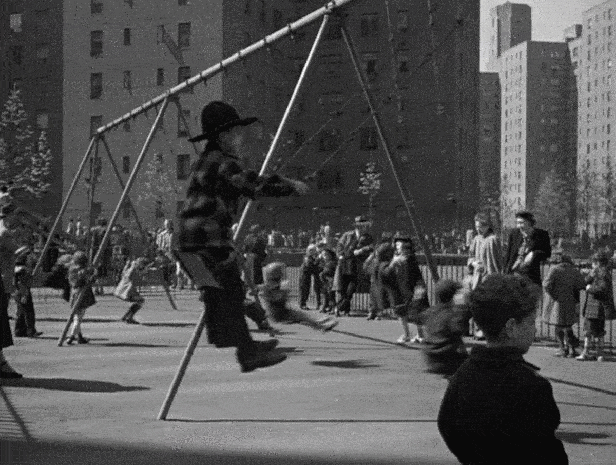
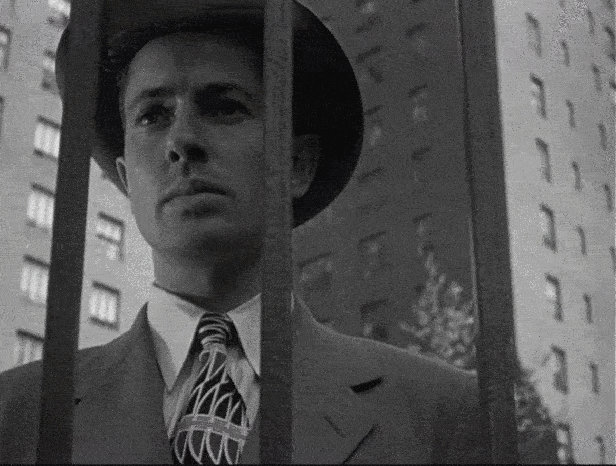
This was a location that was already well-established — cited by several film historians and websites as taking place in Stuyvesant Town in the East Village. However, despite Stuyvesant Town being a sprawling housing complex with multiple recreation areas, no one seemed to indicate where specifically the scene took place.
In order to find this scene’s exact location, it became a matter of figuring out which playground in Stuyvesant Town was the one in the film. Unfortunately, like many of these large housing projects that started going up in NYC post-World War II, Stuyvesant Town is full of identical looking apartment buildings without any real distinguishing markings. So I thought figuring out which quadrant the scene took place in was going to be nearly impossible. That is, until I noticed something interesting while studying an aerial view of the area — on top of only four buildings in the complex there’s an additional tower.
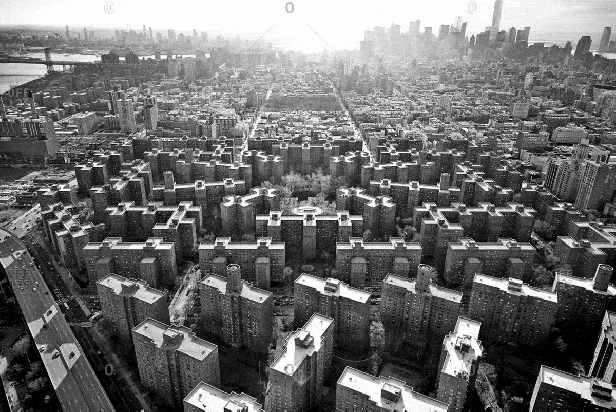
Fortunately, one of these towers appears in the scene when the camera is pointed towards the kids playing. So, with a limited number of towers on the property, I could use them to narrow down the possible locations of the playground. After going to the actual complex, I determined by the angles that the scene took place either at the current playground south of Stuyvesant Oval (with views of the northwest tower), or at the grassy patch north of Stuyvesant Oval (with views of the southeast tower).
I wasn’t able to confirm which of these two possibilities was the actual location (mainly because the surrounding buildings were virtually identical), but since the space south of Stuyvesant Oval is currently a playground I figured that was where the film was most likely shot.
Hospital
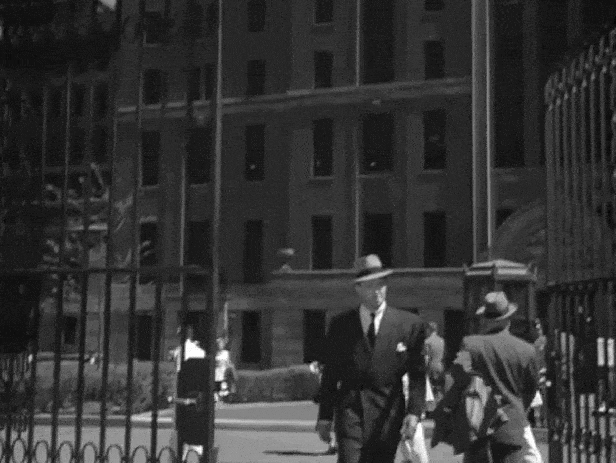
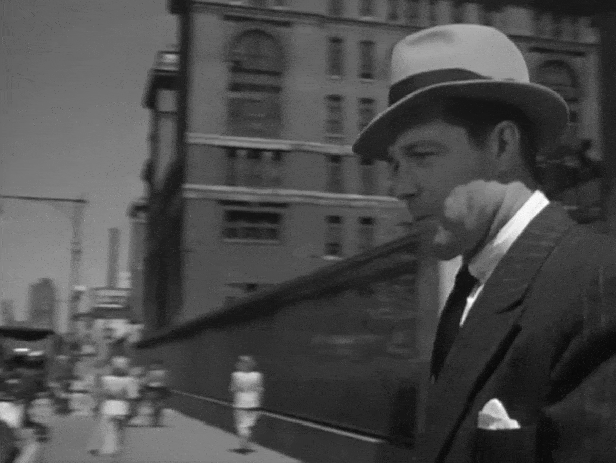
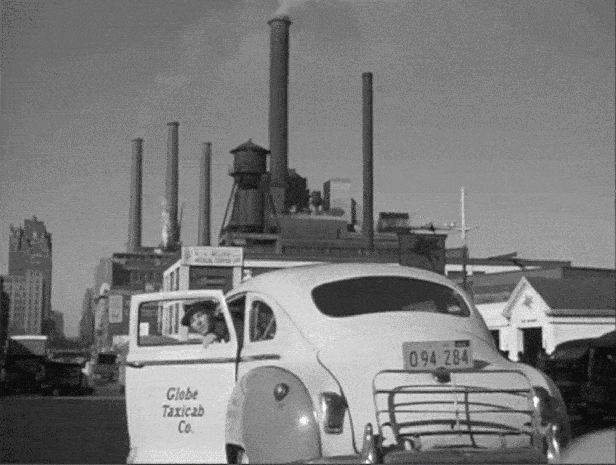
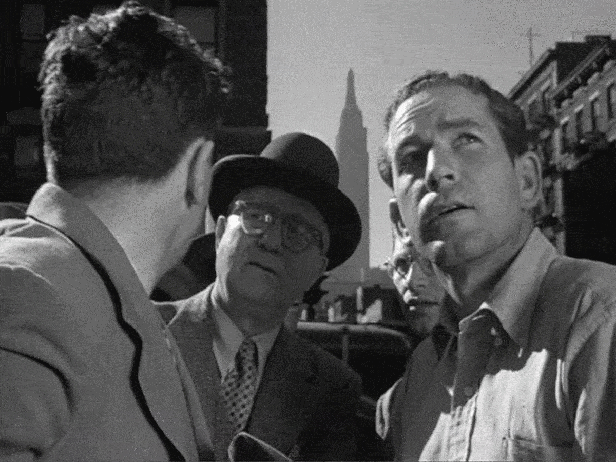
These days, I would’ve quickly determined that this sequence took place at and around Bellevue Hospital on First Avenue, but when I began researching this film back in 2015, I wasn’t too familiar with the famous medical facility and what it used to look like. I eventually figured out this scene’s location thanks to the Empire State Building appearing in the background when Joe jumps out of the cab, placing the action in the high 20s/low 30s on First Avenue.
At first glance, it looked like the old hospital got torn down and replaced with a modern version, but actually, all they did is just put a new addition on the front of the original building. And what’s interesting is that a good portion of the original facade is still visible inside the modern building’s main lobby, so I was still able to take a current photo of the entrance that matched the movie.
When it came to the part where Joe jumps out of the cab, the once-industrial area along First Avenue has since changed a lot since 1949, but I was able to find a couple distant buildings that are still around. Fortunately, I was able to grab a modern photo of the area just before a tall monstrosity went up on First Avenue, effectively blocking the building at
The Neighborhood Bar
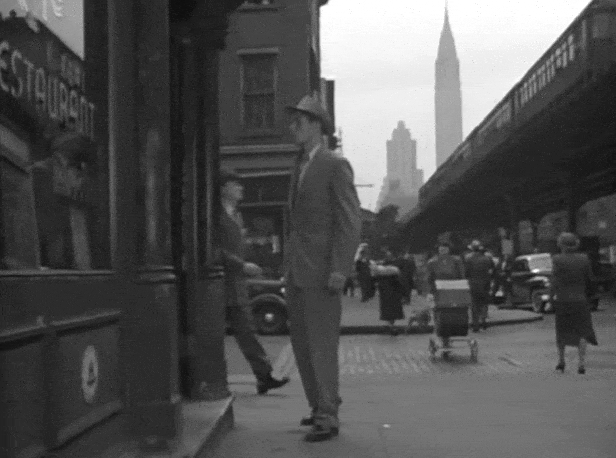

Not much to say about finding this location. The exterior of the bar had already been identified as PJ Clarke’s Tavern on Third Avenue by several reliable sources, so there was no real legwork involved.
However, for a brief time, I thought they actually shot the interiors of the bar on-location as well, but upon closer inspection (once I had a better-quality print of the film), I determined that it was just a nicely-reconstructed set. My first clue was that the cabinet behind the oyster bar at the actual New York location is slightly different from what appears in the film.
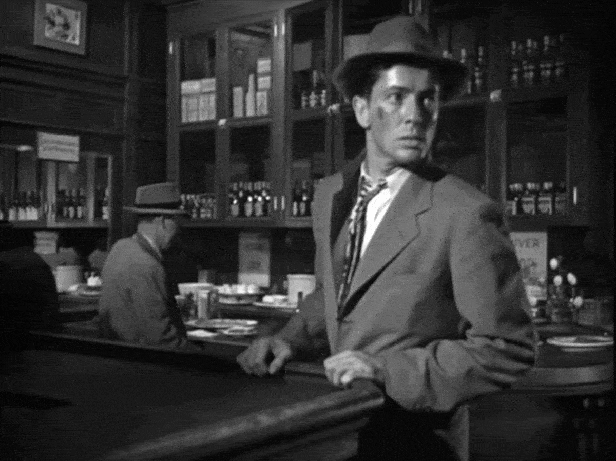
I then determined that the street exterior, as seen from inside the bar, is actually just a rear-projection, hidden nicely by all the glass and framework in the foreground. Interestingly, the Third Avenue El, seen in the background as Joe approaches the bar, disappears as soon as he steps inside. That would suggest that the second unit team, which filmed the background plates, didn’t actually do it on Third Ave.
Going to a Funeral Parlor
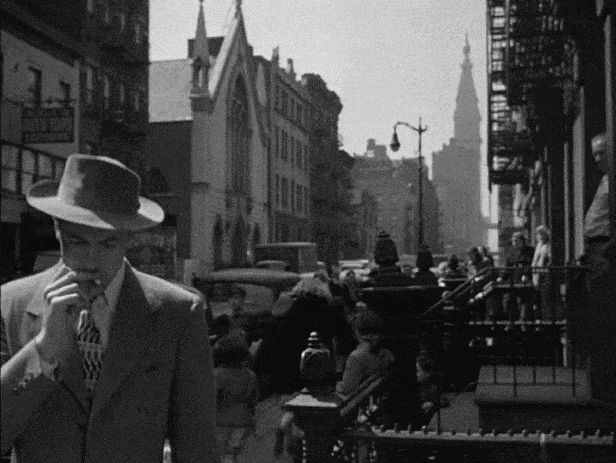
This ended up being a slightly tricky location to figure out, although at first I thought it would be easy, because in the film, Joe is expressly told by the new tavern owners that Nick’s mailing address is 76 Cherry Street.
Since I knew the address Joe gave for his home in an earlier scene was also the actual filming location, I hoped the same would be true with this scene. But when I looked at vintage photos of Cherry Street, and saw that nothing in them matched the film, I realized that this wasn’t the case with this scene’s address.
I’m not sure why in this case the address given in the dialogue was different from the actual filming location, but it might’ve had something to do with the fact that the majority of this scene was shot on a Hollywood soundstage. Only the initial shot of Joe walking up the street was filmed in New York.
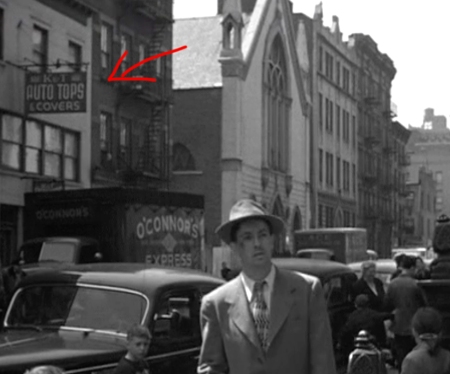 So, knowing that they didn’t shoot this scene on Cherry, I went to the library to look up the address for K&T Auto Tops whose business sign appears across the street in the scene. When I found the address in a 1950 phone directory, it was listed on First Avenue between 23rd and 24th Streets, which didn’t make sense since Joe is clearly walking on a narrower cross street.
So, knowing that they didn’t shoot this scene on Cherry, I went to the library to look up the address for K&T Auto Tops whose business sign appears across the street in the scene. When I found the address in a 1950 phone directory, it was listed on First Avenue between 23rd and 24th Streets, which didn’t make sense since Joe is clearly walking on a narrower cross street.
Then, when I consulted a 1955 map of that area, I noticed that one of the lots on E 24th Street was marked as Saint Sebastian Roman Catholic Church, which I thought might be the same church that appeared in the scene to the right of K&T Auto Tops.
When I looked at E 24th Street on Google Street View, I discovered the entire block had been torn down and replaced with modern buildings. But that didn’t really matter, because way down the street, I could see the unmistakable Metropolitan Life Insurance Company Tower on Madison Avenue which matched the tower seen in the film.
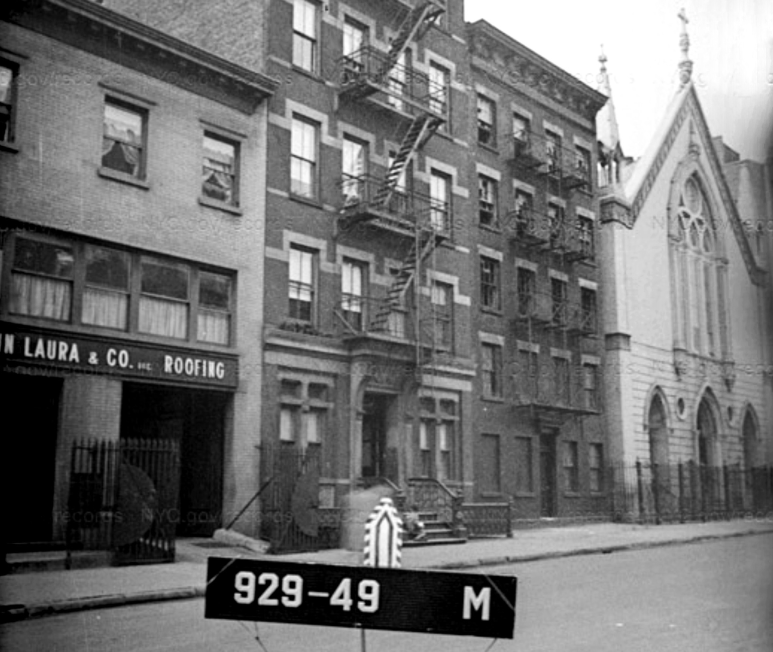
I never figured out why there was a discrepancy with the address for K&T Auto Tops, but once I found a vintage photo of Saint Sebastian, I was certain that E 24th was the correct cross street.
That being said, I was fairly certain that the funeral parlor itself was just a movie set built in Hollywood. And once I got access to the 1940 tax photos (released a few months later in the fall of 2018), I was able to find a picture of where the “funeral parlor” would’ve been, showing a garage for Mobilgas there instead.
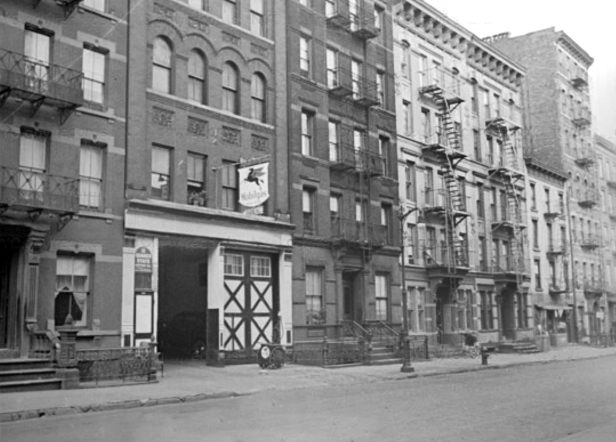
However, another tax photo helped further confirm the location of the initial shot, showing a stoop and railings at 331 E 24th Street that matched the ones on the far right side of the frame in the film.
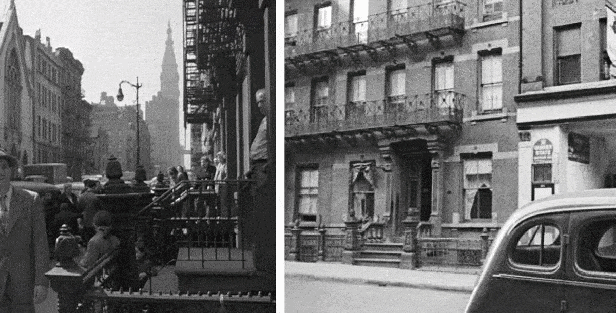
Visiting a Bank
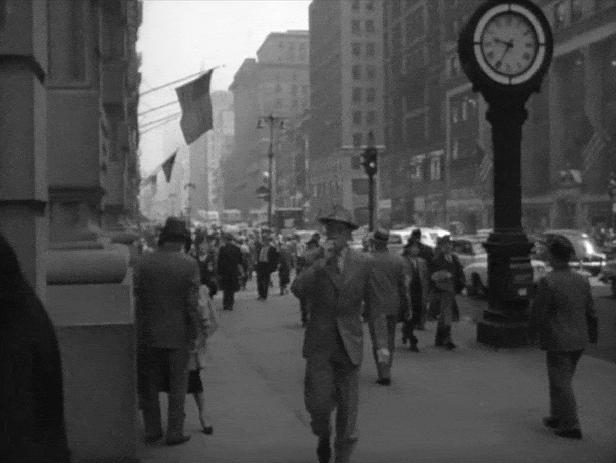
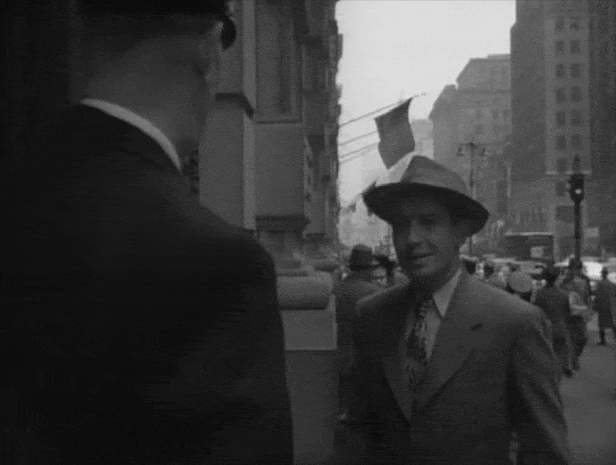
In this scene, there’s a street clock prominent in the background, which I hoped would help lead me to the location.
Back when this film was being made, street clocks were ubiquitous fixtures in the city, but today, there are only a handful of them left. I was familiar with a few of them — there’s one by the Flatiron Building, one up on the Upper East Side that was featured in The Lost Weekend, and another one on Fifth Avenue just below 44th Street which I thought might be the one from this film.
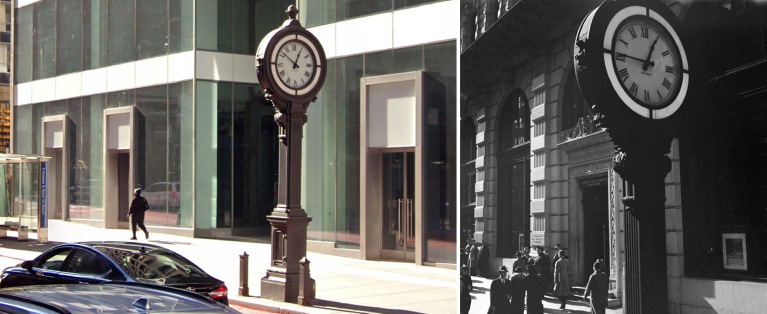
Manufactured in 1907 by the Seth Thomas Company, the large an art-deco black-and-white clock originally stood on Fifth Avenue and 43rd Street in front of the American Trust Company. But in the 1930s, it was moved one block north to its current location, in front of what was colloquially known as the Guaranty Trust Company building.
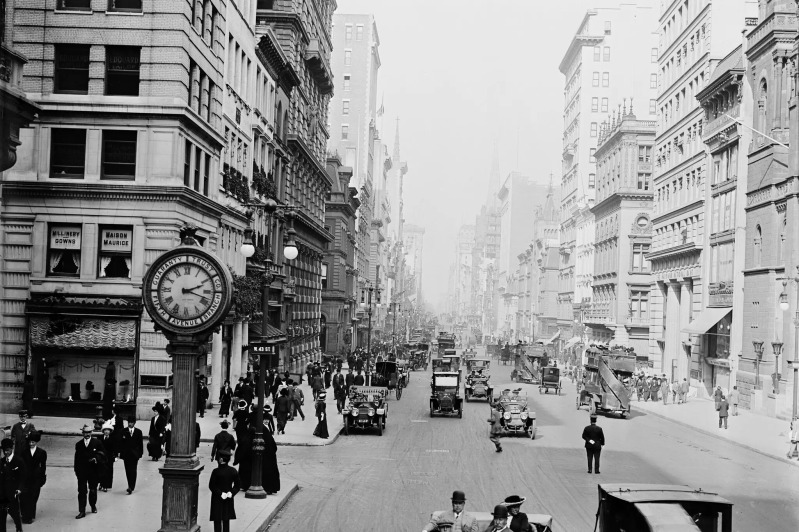
In 1981, the clock at 522 Fifth Avenue, along with seven others throughout the city, were designated landmarks by the Preservation Commission, ensuring its place in this continuously-modernizing city.
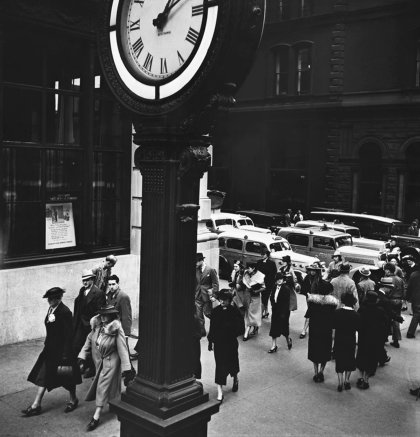
Incredibly, this rare clock, saved by the Landmarks Preservation Commission, turned out to be the same one that appeared in Side Street. And just to be sure I had the right location, I matched up several extant buildings on Fifth Avenue with the ones seen in the background of this scene.
Once I confirmed the location of the bank exterior, I erroneously thought the interior was also shot in the same building. This mistake came when I saw that the ground floor at 522 Fifth had several load-bearing posts which could conceivably be the ones seen in the film.
But then I spotted something peculiar about an early bank scene that made me rethink where they shot the interiors. At the beginning of the film, when the blackmail victim enters the building, the actor was evidently in front of a rear-projection screen, which meant they probably shot it on a soundstage in Hollywood. With that in mind, I rewatched a later scene that took place in an alley with actor Whit Bissell, who played the bank clerk, and that looked like it had also been done in Hollywood. That made me think that all the scenes involving Bissell were shot on the west coast, including the bank interior.
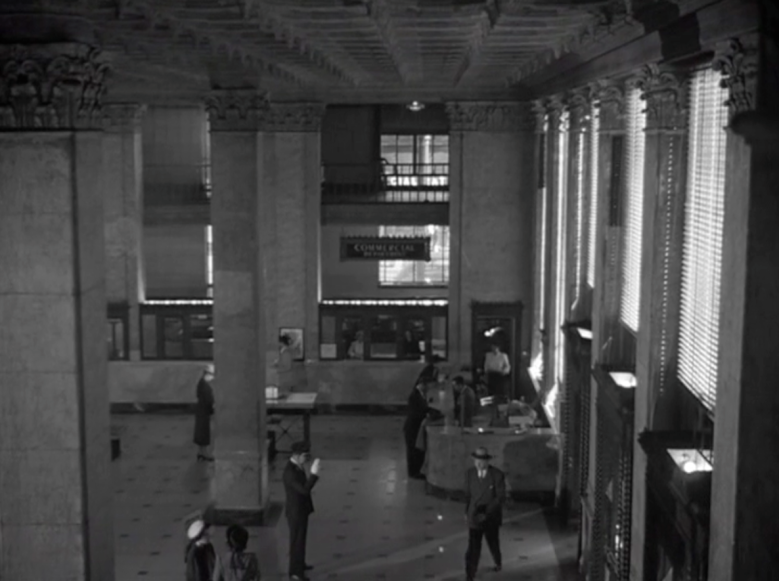
That led me to do an online image search for “banks in Los Angeles,” to see if I could find the one used in the film. When I did this image search, I adjusted the settings to give only black-and-white results (a good tool to use if you’re trying to narrow your results to pre-1970’s) and found one image of the Pacific Southwest Trust and Savings Bank which had a similar-looking ornate lobby with square posts and an intricate coffered ceiling.
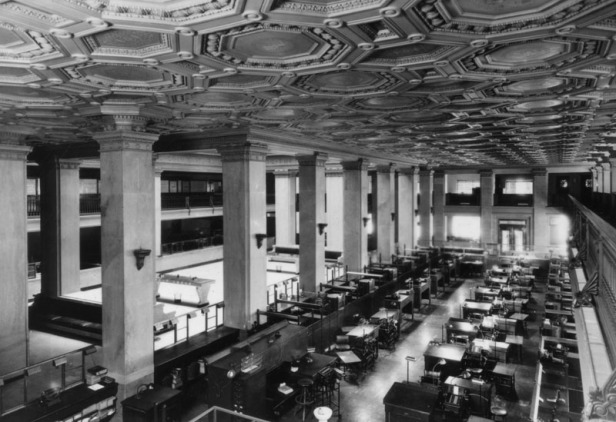
But upon closer inspection, I could see that the pattern on the floor didn’t match, and the details on the posts and ceiling were different as well.
Continuing my search, I eventually found a blog by author and L.A. historian, Kim Cooper, that featured a 1923 photo of the “Bank of Italy,” whose floors, columns, and ceiling seemed to match the film.
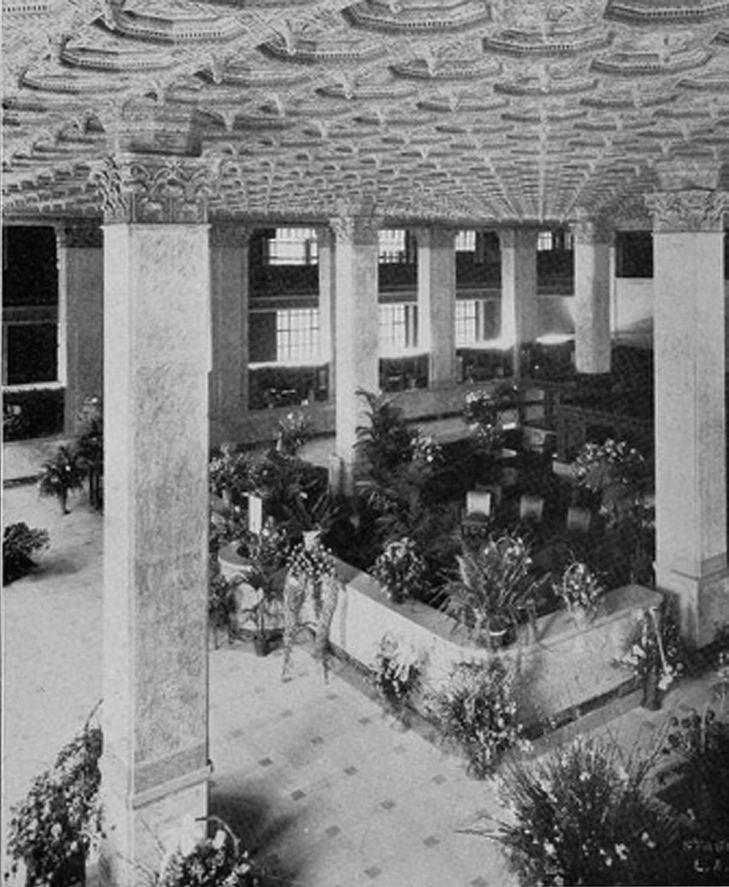
I then did a search for “Bank of Italy” to see if I could find additional images. Surprisingly, I couldn’t seem to find any other photographs, but I did find a postcard that had an illustration of the “main banking room.” Even though it was just a drawing, it offered some nice details, including that of the customer tables used to fill out banking slips, which were identical to the ones seen in the film.
Curious as to whether the building still existed, and if so, whether the interior retained any of the original decor, I was pleased to learn that the space has been converted into a hotel and restaurant —albeit an extravagant, fancy-pants one I’d normally never set foot in— keeping in place many of the ornate Neoclassical fixtures seen in the film.
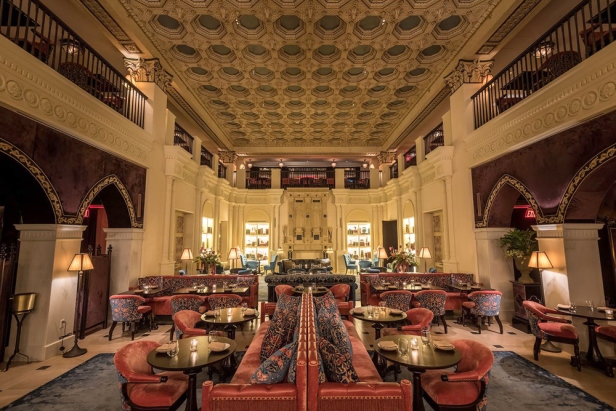
It’s fortunate that the building —along with its Doric columns, marble floors, golden-coffered ceilings and original bank vault— has been lovingly preserved. So on my next trip to LA, it’s good to know that I can go inside the former “Bank of Italy,” and stand where the entire plot of 1950’s Side Street was set into motion.
Late Night on the Pier
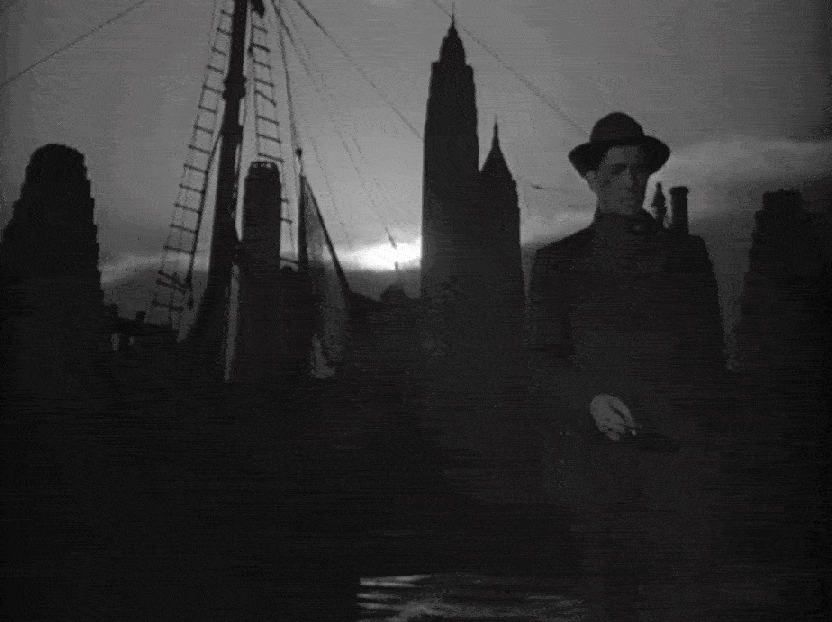
This was clearly on a pier somewhere in Lower Manhattan. I simply used the orientation of the two towering skyscrapers at 40 Wall Street and 70 Pine in the background to get a general fix of where Ganger was standing. It was a little hard to get the exact spot with all the new buildings that have since gone up in the Financial District, cluttering up what was once a fairly sparse skyline.
Village Beauty Salon
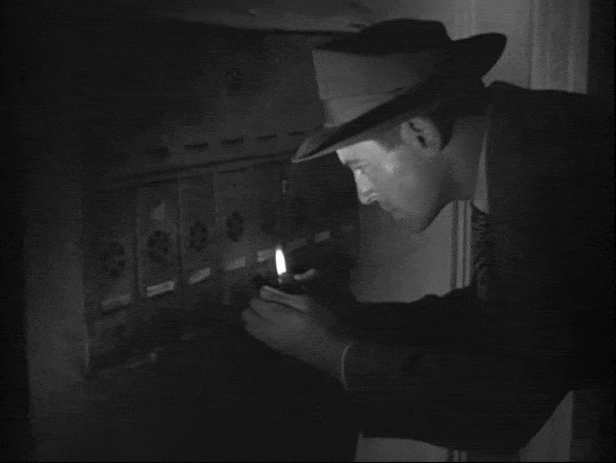
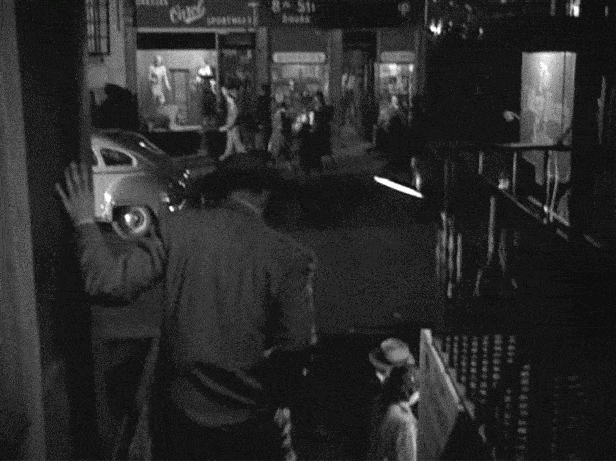
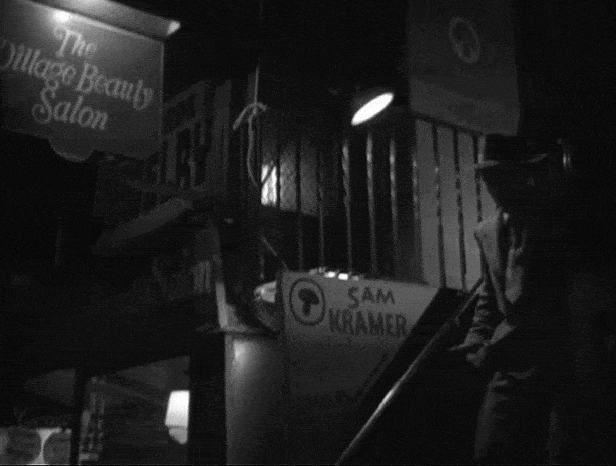
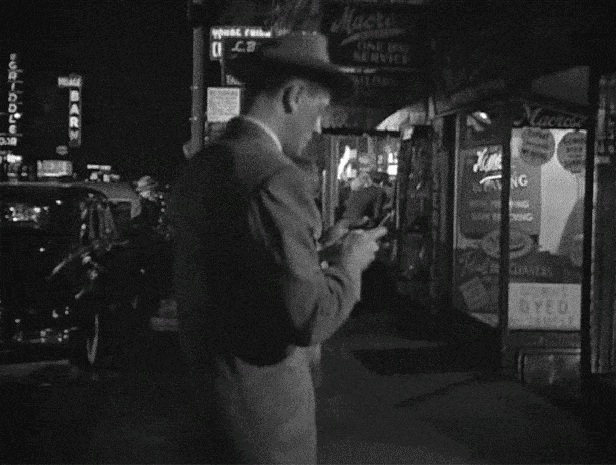
This was the first location I was able to find for this film, and it was super easy. That’s because when Joe looks up the beauty parlor’s address in a phone directory in the previous scene, what’s shown on screen —29 W 8th Street— is the actual filming location.
So essentially, the character of Joe Norson did all the research for me.
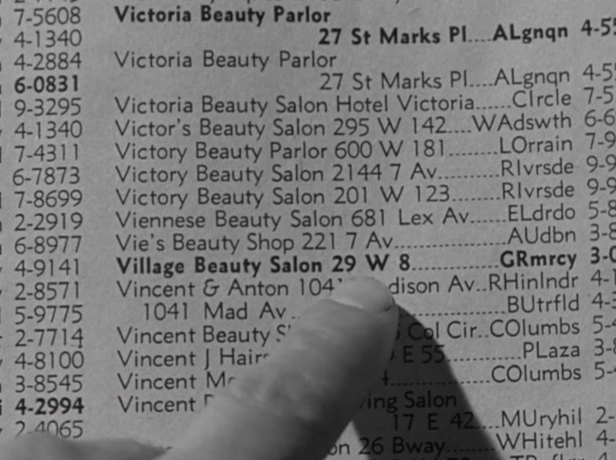
Needless to say, I was pleased to see that the building was still standing, with its unusual display “balcony” on the second story. Although, a year later, when I stopped by the location, I noticed that the clothing shop that was on the second floor had since closed, and the mannequins gone. Hopefully this isn’t a sign that the building is about to be taken down.
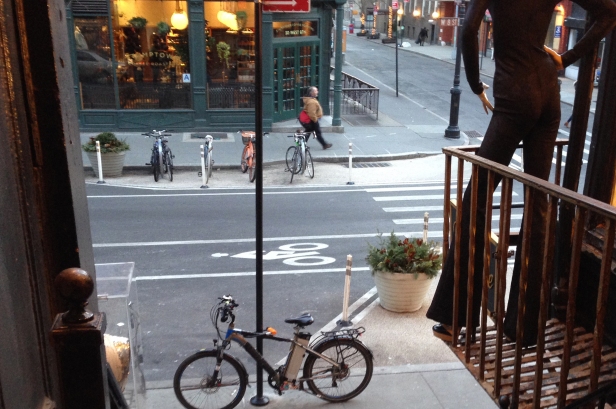
Searching Nightclubs
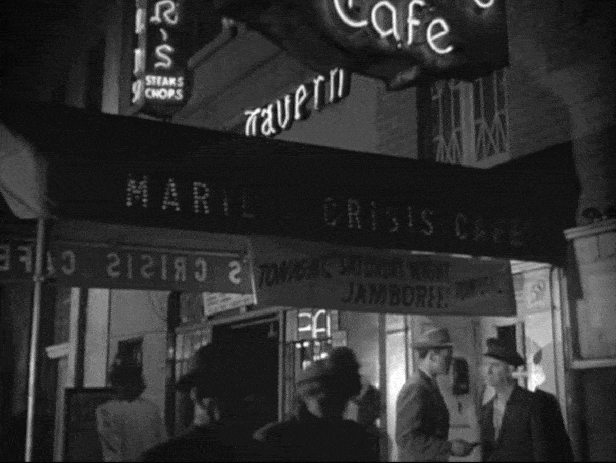
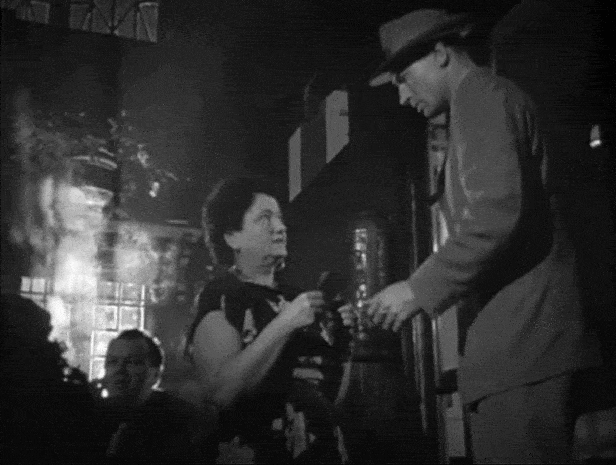
Whenever there’s a clearly marked business sign in a scene, that’s obviously where I start when trying to figure out a filming location. By the looks of the signs in this scene, I was pretty sure this was an actual location and not a movie set (unlike the nightclub where Joe finally finds the girlfriend). It didn’t take much searching online before I found the location of Marie’s Crisis Cafe, and I was absolutely surprised that it was still in business (along with the neighboring Arthur’s Tavern).
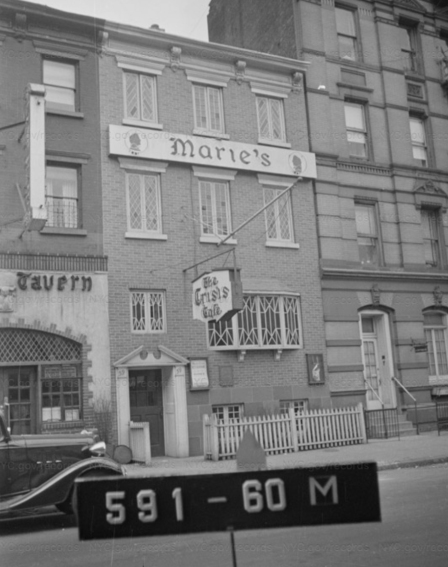
This old West Village watering hole has been around, in one form or another, since the 1850s, starting as a prostitutes’ den and later becoming a speakeasy that was, according to a 1929 NY Times interview with Police Commissioner Whalen, “a breeding place of crime and a menace to the health and morals of the community.”
After the end of Prohibition, it was bought by chanteuse Marie DuMont (who is the woman Joe talks to in this sequence) and the space became a bohemian bar and restaurant called, Marie’s Crisis Cafe. The “Crisis” is a reference to “the Crisis Papers” written by Thomas Paine, who died in 1809 in a small wooden house that once occupied the site where the brick building at 59 Grove Street now stands.
At the time Paine was living there, Grove was a little dirt road known as Columbia Street which ran through a Greenwich Village farm. Years after Paine died, Columbia was widened, paved, and renamed Grove Street. As the neighborhood became more geared towards middle class families, a row of five matching Federal-style brick-homes were erected on the street, including the one at no. 59.
Owned and operated by Marie DuMont for nearly 40 years, Marie’s Crisis Cafe was eventually purchased by the current owners in 1972, who turned the space into a sing-along piano bar in which neighborhood gay men and musical theater performers have gathered over the decades to belt out show tunes.
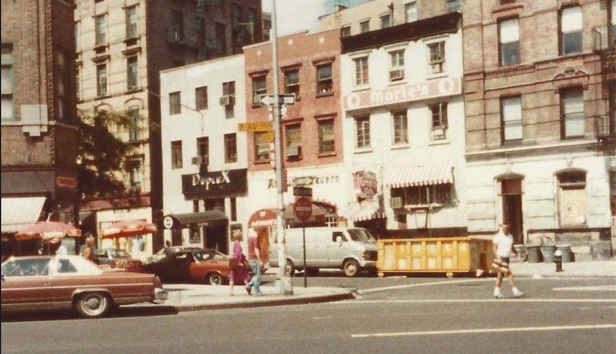
According to the bartender I talked to when I went there to take the “after” pictures, the reason Marie’s has survived so long is because the owners of the bar also own the entire building and don’t have to worry about steep rent hikes that have obliterated so many small NYC businesses in recent years. Even though the space has changed quite a bit since they filmed this scene in 1949 —most notably the dark wood drop-ceiling that was installed to add a second floor to the bar— it was exciting to see that the nightclub Farley Granger visited in 1949 was still in business.
In the movie, after Harriet tricks Joe into going to Garsell’s West Village apartment, she’s ultimately strangled to death by Garsell in the backseat of a cab parked outside.
I could tell those exteriors of Garsell’s apartment were shot on a studio backlot, and since this film was released by MGM, I searched old photos of the lot to see if I could find anything that looked the same. I eventually found one hi-res image that seemed to show one the buildings that appeared at the end of the narrow street the apartment was on.
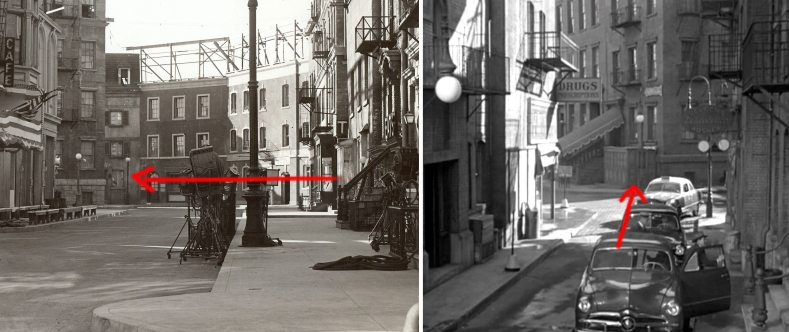
After the characters leave Garsell’s apartment, the rest of the movie is essentially one long sequence, ending with a climatic car chase taking place all over southern Manhattan.
I will cover the vast filming locations involved in that sequence in PART 2.
Pages: 12
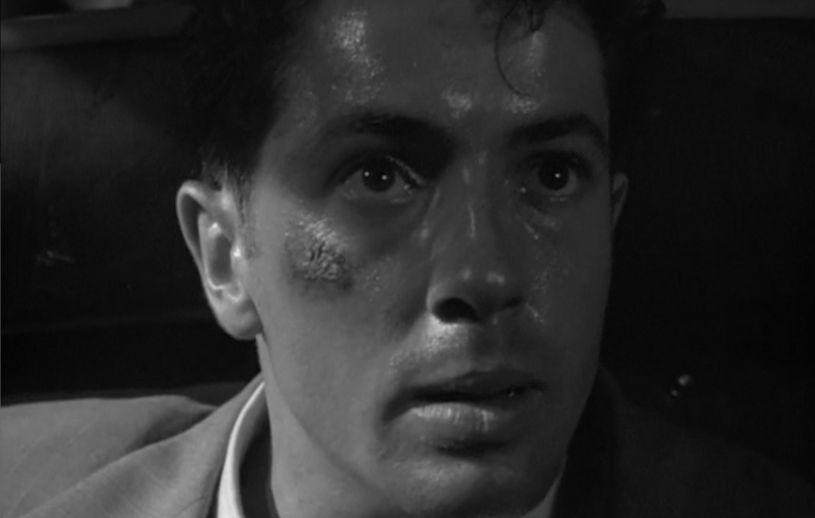
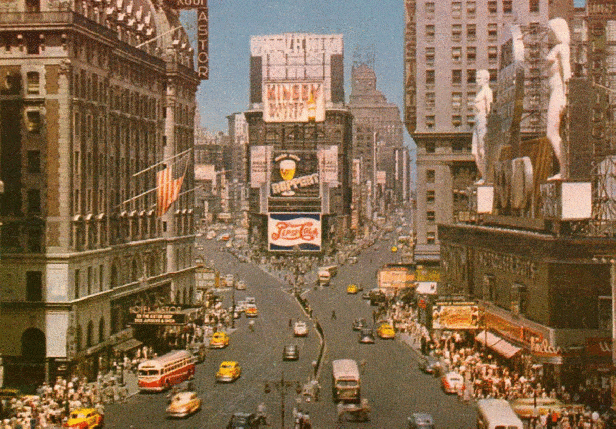
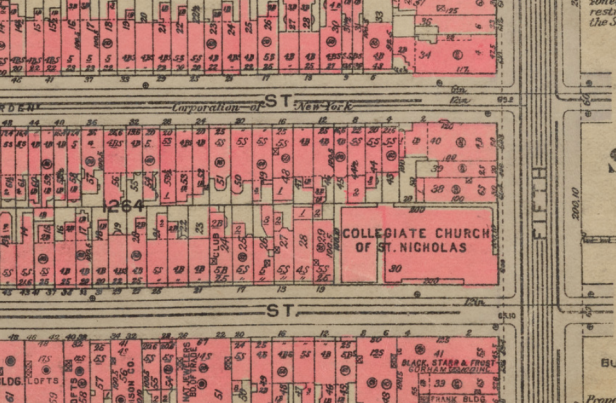
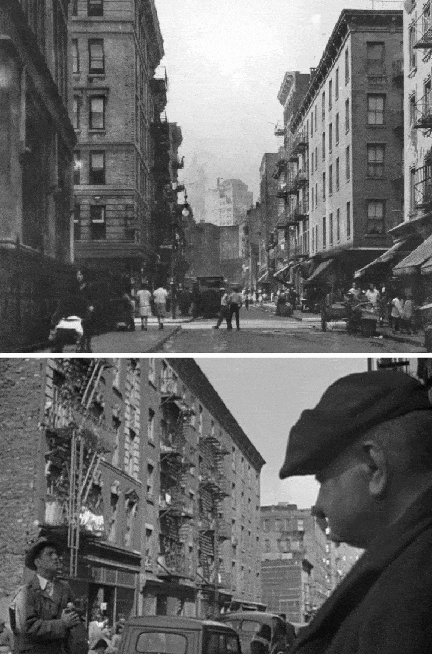
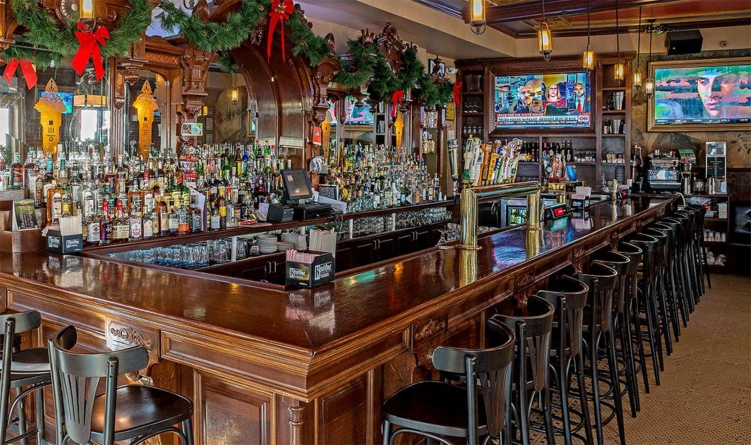
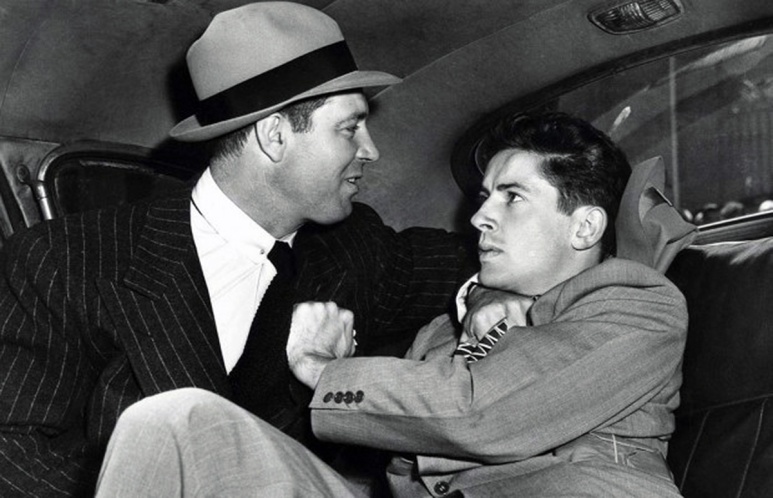
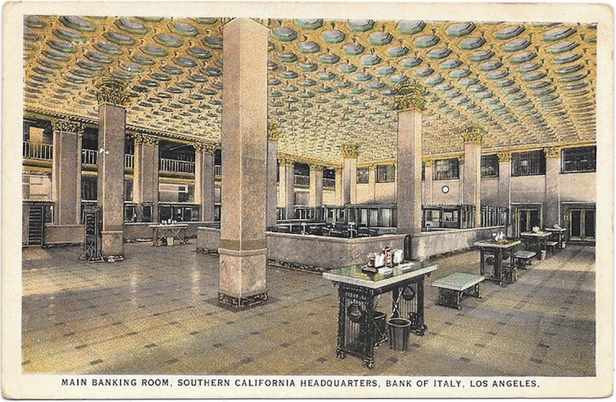
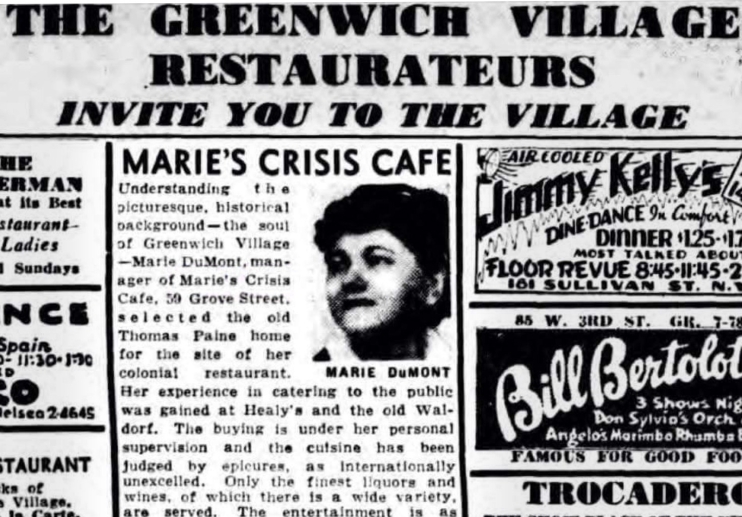

Like!! Great article post.Really thank you! Really Cool.
LikeLike
Wonderful piece! Lower Manhattan is changing at an accelerated pace the last few years. The north half of the St John’s Terminal came down in 2019, with West Houston now uncovered by West Street. Very weird!
LikeLiked by 1 person
Yeah looks like I grabbed a pic of that location in the nick of time. I just walked past that part of Houston last week and didn’t even recognize it. I will miss that tunnel.
LikeLike
I didn’t realize there were so many nyc locations used in this film. Incredible time capsule!
LikeLike
I saved your article on Side Street until after I watched the movie. What a fantastic bit of investigation! Having been to NYC recently I was able to identify many locales myself, and your background information e.g. 13th Ave, is fascinating. Your hard work is very much appreciated!
LikeLiked by 1 person